


















Patients who currently have an appointment set might be able to move it up, according to Planned Parenthood.
BY MADELINE FENING
Ohio’s 24-hour waiting period law for abortion patients has been put on pause by a Franklin County Judge on Aug. 23, effective immediately. The 24-hour law, which required patients seeking an abortion to wait 24 hours after a consultation appointment to think about their decision, is being challenged by American Civil Liberties Union (ACLU) lawyers on behalf of abortion providers.
In a recent cover story on the 24-hour rule, one patient told CityBeat she was made to wait 24 hours to begin removing a miscarrying pregnancy, despite her own health being on the line. Abortion providers also told CityBeat the requirement negatively impacted all abortion patients in one way or another – from domino effects on scheduling, to financial burdens on out-of-state patients. Former Dayton mayor and Democratic candidate for Ohio Governor Nan Whaley, who was named the newest CEO for Planned Parenthood Southwest Ohio in June, said the law’s pause is already benefiting out-of-state patients.
“We’re taking scheduling day by day and reviewing each patient’s case individually, because that’s what this is about, is making sure that each individual patient gets the care they need and deserve without superfluous rules behind the government that don’t have anything
to do with health and safety,” Whaley told CityBeat. “As early as yesterday, we were able to provide support to a person out of state that would have had to stay overnight.”
Reviewing individual cases, Whaley said, includes reaching out to patients to ask if they want to move up their appointment.
“We are the first abortion clinic you get to from Key West on I-75,” she said. “So, our patient navigators, I think they’ve made almost like 900 calls this month, always working to make sure that we’re getting people the care they need as quickly as possible.”
The current wait time for an appointment at Planned Parenthood Southwest Ohio, which includes locations in Cincinnati and Dayton, is about 17 days, Whaley said. This could get shorter as time goes on with the pause on the 24-hour rule.
“This is our expectation, that we’re going to be able to get folks in sooner, which opens more options to them,” Whaley said. “This could mean the difference between them having a choice between a medical abortion, a medication abortion or a surgical abortion. It just gives more options as we’re moving forward.”
Patients who currently have an appointment set might be able to move up their appointment, but Whaley said
it’s best to call first.
“The best thing for patients to do, if they’re already on the schedule, is to call us and talk this through about what’s best for them. They should definitely keep their day, but they should also call in, and particularly to see if they can get sameday if that’s what they want.”
Franklin County Court of Common Pleas Judge David C. Young also paused the minimum two in-person visit requirement and specified information disclosure about abortion, including the “probable gestational age of the zygote, blastocyte, embryo or fetus” and “nature and purpose of the particular abortion procedure to be used,” according to state law.
Whaley said patients, no matter the law, will always have the option to take as much time as they need to make their choice.
“Any patient who is not 100% certain of the choice should take the time they need to make the decision that is right for them. Full stop,” she said. “Just because we can provide abortion care on one day does not mean that it is the best option for each individual. And frankly, this is the art of medicine and being allowed to practice in a way that best serves each and every individual.”
The ACLU’s lawsuit is set to go to trial in April 2025.
BY LILY OGBURN
Lora Thompson, a Cincinnati veteran, served in the military for over 38 years. It wasn’t until 2018, a year before she retired, that she discovered the Greater Cincinnati Women’s American Legion Post 644, an allfemale post dedicated to women veterans.
“How in the world do you go 30-some years without knowing about an all-women’s post that started after World War II?” Thompson said.
Female veterans are a historically underserved group, both by the U.S. Department of Veterans Affairs (VA) and in local community support. One of the biggest challenges with ensuring these women receive medical care and community support is reaching them and spreading awareness about existing resources.
According to the VA, women are the fastest-growing demographic in the military. By 2040, women are expected to make up 18% of all veterans.
This growth only emphasizes the importance of medical programs, psychological support, community groups and additional resources for women veterans.
Zooming in on Cincinnati, according to data from the U.S. Census Bureau, 11% of veterans in Hamilton County are women. Thompson told CityBeat that there were an estimated 67,000 female veterans in Ohio in 2022.
“What we have is a lot of little organizations out there that help women, but, in my opinion, we could do a better job streamlining the process and making it more efficient and helping each other,” Thompson said. “So that’s one of the areas that I’m working on.”
Thompson is now the Post Commander of Post 644. From bringing donuts and coffee to the Cincinnati VA Medical Center to sponsoring baby showers for women veterans, the group does crucial
community-building work for female veterans.
Thompson is also campaigning for a temporary housing and support facility for women veterans in Ohio with the Tunnel to Towers Foundation, an organization dedicated to eradicating veteran homelessness.
“My passion is to have a state-ofthe-art facility for women veterans to go to that is kind of an in-between place where we help them find their housing and help them get their appointments,” Thompson said.
Post 644 also helps women veterans connect with the VA to get medical care, including care for posttraumatic stress disorder (PTSD) and military sexual trauma (MST).
“One of the reasons that we have low numbers of women registering [with the VA] is because they’ve been told falsely that their service didn’t count unless they were an infantry person, or for whatever crazy reason,” Thompson said. “All of that is bogus. We have to take away that lie and tell them that if you have a 214 [form] in your hand, you’re entitled to care.”
Dr. Kathleen M. Chard is the associate chief of staff for research and the director of the Trauma Recovery Center at the Cincinnati VA Medical Center. There, she helps run one of the leading women’s treatment programs in the U.S.
Patients travel to the medical center from all over the country, she
said. However, it’s also about treating veterans close to home.
“At any time, Ohio ranges from the fifth-most to seventh-most womendeployed veterans in the United States,” Chard said. “Ohio is a big contributor to the military, and so being able to have services for the veterans here is really, really important to me.”
According to Chard, the Cincinnati VA Medical Center was only the third women’s treatment program in the country at its founding.
“In Cincinnati, we were one of the first VAs to say that it doesn’t matter whether your PTSD is from childhood experience or the military sexual assault,” Chard said. “We’re here to treat you. We treat all of your trauma.”
Chard has been at the Cincinnati VA for about 20 years, and since her arrival, she’s developed two residential treatment programs. One is specifically for female veterans.
The program brings together cohorts of women to receive treatment over the course of three or seven weeks. The program employs evidence-based treatment, including cognitive processing therapy, to help veterans work through PTSD, MST and any other trauma they may be experiencing.
“There’s still old ‘mythology’ that you can’t treat PTSD. People still use language like, ‘You just manage the symptoms,’ that you’ll always have it,” Chard said. “I always say, why, if we

are built naturally to recover, should we subject you to a life of misery when it’s just about getting the body to do what it’s naturally meant to do?”
For both Thompson and Chard, spreading awareness about their offerings is one of their top priorities. They are both dedicated to reaching women veterans of all different backgrounds, they said.
“We tell [members], ‘You guys had aunts, you had grandmas, you had wives, you have sisters and daughters who served. Hey, we’re out here.’ We want to be a part of who they are,”
Thompson said.
For Thompson, providing community for female veterans is a crucial piece of the puzzle. She told CityBeat that women veterans have an unbreakable bond.
“There’s a true community, especially with women, when a lot of them have been told that they don’t matter and they don’t count,” Thompson said. “[This is] a group of women that just need to be reminded of what they’ve already done and what they have the power to do in community going forth.”
BY MADELINE FENING
The Friends of Sherrod Brown campaign launched “Asian Americans and Pacific Islanders (AAPI) for Sherrod” coalition on Aug. 28.
Brown is running for re-election for his U.S. Senate seat against Republican challenger Bernie Moreno, a hard-line immigration reform Republican. Moreno, an immigrant from Colombia, supports former President Donald Trump’s mass deportation plan. Axios reported in early August, if elected, Moreno said immigrants will only be allowed to take the U.S. citizenship test in English. He also wants to block immigrants from government benefits for their first 10 years in the U.S., and told supporters during a campaign stop what he expects of people entering the country: “They learn the language, like I did. They
assimilate, like I did. They understand the culture, like I did,” Axios reports.
In an exclusive sit-down with CityBeat , Brown said Moreno’s talking points are simply scare tactics.
“So often things he says are already the law or he makes it up,” Brown said. “He accuses [his opponents] of saying that we want people that are here undocumented to get Social Security. The fact is that, people, if you’re working here without documentation, you’re working into Social Security, you’re certainly not getting it. You’re not allowed to vote. They engage in scare tactics, always.”
Brown added that Moreno, who is anti-abortion, is out of step with Ohio’s voters, including those in the AAPI community.
“I think on issues of reproductive

Sen. Sherrod Brown
PHOTO: BROWN.SENATE.GOV
rights, Ohioans, including most people in the Asian, Asia Pacific community, voted overwhelmingly for reproductive rights,” he said. “And Bernie Moreno still says that he wants a national abortion ban, no exception. So it’s not just out of step, it’s also contrary to what voters in the state wanted.”
Cincinnati Mayor Aftab Pureval joined CityBeat’s discussion with Brown, calling Moreno’s immigration rhetoric “xenophobic” and a threat to business growth in the state.
“It’s obviously having a tremendously negative impact on our local AANHPI community, but it’s also having a broader negative impact on our ability to grow as a community and to compete on the world stage for the best and the brightest talent to come,” Pureval told CityBeat . “You know, Procter and Gamble, Kroger, GE Aviation, Cincinnati Children’s — number one in the country — are all in a fight for the best and the brightest talent, not just here in our region or our country, but across the world. [...] with this xenophobic and oftentimes racist rhetoric coming from from Senator Brown’s opponent, it only makes it more difficult for mayors like myself to recruit not just businesses to come here and to grow and to invest in our community, but also to bring the talent.”
Bernie Moreno’s campaign did not respond to CityBeat’s request for comment for this story. In an emailed release, Brown’s campaign emphasized his Senate victories for the AAPI community, including:
Introducing a resolution to condemn all forms of antiAsian sentiment, racism, and discrimination.
Calling on federal officials to address the rise in hate crimes during the COVID-19 pandemic.
Establishing the Congressional Taiwan Caucus, advocating for Taiwan’s observer status in the World Health Assembly.
Working with Bhutanese American community members to introduce a resolution recognizing the Kingdom of Bhutan as responsible for the forced eviction of over 100,000 Bhutanese citizens in the late 1980s and 1990s.
Brown’s membership in the U.S. Senate India Caucus, aiming to strengthen U.S.-India ties through “mutual trust and respect, while promoting security for all.”
Election Day is Tuesday, Nov. 5, 2024.
BY MADELINE FENING

Cincinnati’s animal welfare scene is getting a significant upgrade. Hamilton County Commissioners have authorized a $10 million investment to purchase land for a new, state-of-the-art animal shelter for Cincinnati Animal CARE (CAC), Hamilton County’s only open-intake animal shelter.
The project also includes an additional $6.2 million for renovating Cincinnati Animal CARE’s existing overflow facility on Dane Avenue in Northside, positioning it as a secondary location once the new shelter is up and running.
The new facility is planned for an 80-acre site at the corner of Gray and Winton Roads in the Spring Grove neighborhood, just two miles from the current location in Northside. The facility promises to be a substantial upgrade from the cramped, outdated Colerain Avenue location, which sits on just three acres.
The current shelter, still owned by SPCA Cincinnati and leased to CAC, has struggled to meet the needs of its
shelter population. A 2023 investigation by CityBeat found shelter employees were resorting to sharing office space with dogs due to a lack of available kennel space. CAC says the new site will allow the shelter to provide more humane, comfortable and efficient conditions for the animals.
“We are so thankful to the Hamilton County commissioners for prioritizing a new animal shelter in Hamilton County,” said Shelter Director Meaghan Colville. “The current facility at Colerain Avenue was built as ‘the pound’ in the mid-60s and was not designed for modernday animal sheltering. Aside from countless facility issues due to age and neglect, it is simply not big enough or designed for what Hamilton County currently needs.”
The move comes after a series of challenges at both locations. In April 2023, the Dane Avenue facility was activated as an emergency overflow site following a canine distemper outbreak at the Colerain Avenue
shelter. The upcoming four-phase renovation will prioritize upgrading the kennel systems, improving the environment for the dogs and creating a more efficient layout for staff and volunteers, according to the release.
CAC says the new facility will take several years to complete, but they’re hopeful construction can begin in 2025, running simultaneously with the updates at Dane Avenue.
Renovation work at Dane Avenue is set to start in January 2025, but CAC says it will require the community’s help to foster or adopt animals currently housed there during renovations.
“Support and cooperation from the community will be vitally important to the timeline for the completion of the project,” the release reads. You can review CAC’s adoptable animals at cincinnatianimalcare.org/ adopt.
BY ZURIE POPE

Nearly $5.5 million in grant funding has been awarded to reduce the impact of opioids, stimulants and other illegal substances in Ohio’s communities, according to a press release shared by the Office of Criminal Justice Services on Aug. 28.
The funding for these grants comes from the Comprehensive Opioid, Stimulant, and Substance Use Program (COSSUP), which will “provide resources supporting the development, expansion, or enhancement of substance use deflection and pre-arrest diversion programs.”
Numerous organizations in Hamilton County and the surrounding area received grants, including: Amberley Village, Hamilton County – $376,443.60
Middletown Division of Police, Butler County – $115,776.64
Cordata Healthcare Innovations, Inc., Hamilton County – $355,715.22 Talbert House, Hamilton County – $792,744.70
Dr. Kelly Firesheets is vice president for strategy and partnerships at Cordata, a Cincinnati based software company that works with community leaders to serve “at risk,” populations. During her interview with CityBeat, Firesheets praised Cordata’s work on Quick Response Teams (QRTs) that are trained to respond when overdoses and other addiction-related incidents occur.
“The QR team model is the most widely replicated form of overdose response in the country,” Dr. Firesheets said, adding that her team has gotten to work with law
enforcement agencies and healthcare providers throughout Ohio through this project.
“I spent a lot of time learning about what addiction was,” said Daniel P. Meloy, former Colerain Township Chief of Police and current director of operations for Operations 2 Save Lives & QRT National – a Cincinnati-based public health group that collaborates with Cordata – when asked about his time as a police officer during the opioid epidemic’s height.
“We didn’t go to any classes about how to collaborate to respond to addiction, or complex issues and problems within your community. All I knew from the problem solving was: we have to collaborate,” Meloy said.
Meloy now works with law enforcement officers and public health experts to educate communities on the best way to handle drug crises in their community.
“As law enforcement, sometimes we have to say: how can I be helpful? Rather than being the leader,” he said.
Ohio was heavily impacted by the opioid epidemic. According to a 2018 article from nonprofit health researcher Altarum, “From 2014 to 2016, Ohio was leading the nation in the number of opioid overdose deaths,” while an analysis from Yost’s Scientific Committee on Opioid Prevention and Education published in 2021 found, “More Ohioans died of an opioid overdose during a three-month period last year than at any time since the epidemic began.”
Opioid-related overdoses accounted for the deaths of 3,237 Ohioans in 2018,
according to an analysis from the National Institutes of Health.
Fentanyl has been equally deadly, with 3,579 fentanyl-related opioid deaths occurring in 2023.
For Hamilton county, the opioid crisis reached its height in 2017, when 570 people overdosed, though the number has steadily dropped since then. The Ohio Department of Health, in its 2022 Unintentional Drug Overdose Report, discovered neighboring Butler county had 55 unintentional drug overdose deaths per 100,000 members of the population.
Other recipients for the COSSUP grant include:
• Lawrence County Prosecutor’s Office, Lawrence County – $418,316.96
• Franklin County Office of Justice Policy & Programs, Franklin County – $838,866.10
• Lorain County Sheriff’s Office, Lorain County – $449,615.20
• Portage County Sheriff’s Office, Portage County – $369,609.28
• Ross County Sheriff’s Office, Ross County – $128,072.10
• Medina County Drug Task Force, Medina County – $241,975.72
• Defiance County Sheriff’s Office, Defiance County – $117,821.11
• The MetroHealth System, Cuyahoga County – $440,229.00
• Northeast Ohio Medical University, Portage County – $587,996.44
• Muskingum County Prosecutor’s Office, Muskingum County - $205,062.41

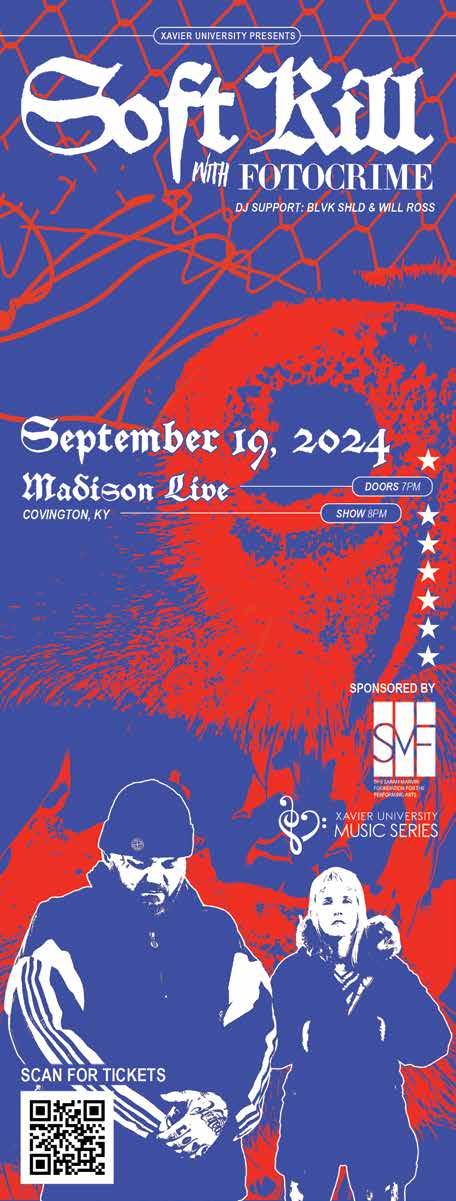



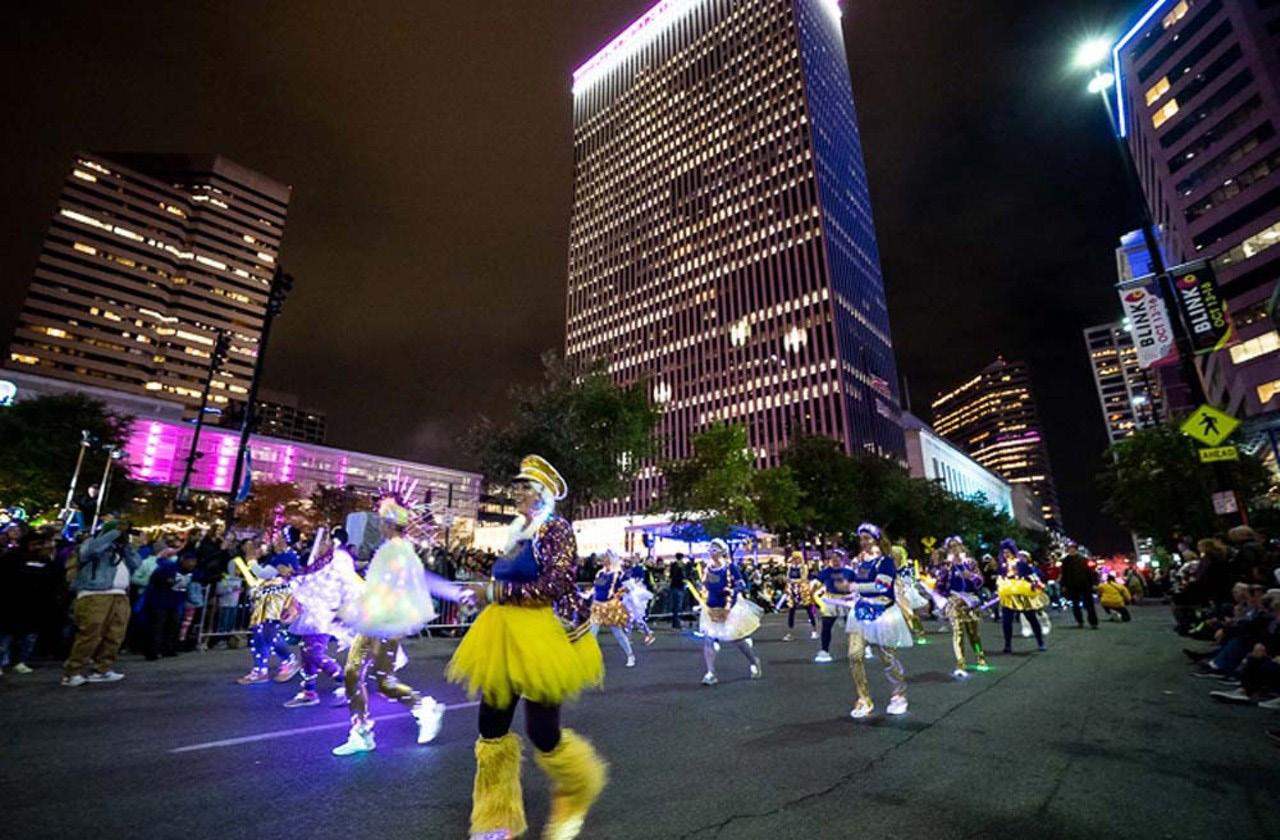
BY KATHERINE BARRIER
In mid-October, Cincinnati will once again be awash in the glow of colorful murals, shimmering light displays and vibrant art installations as BLINK returns with more of, well, everything — more artists, more artworks, more events and a bigger footprint than ever before. From Findlay Market in Over-the-Rhine to Covington in Kentucky and now in Newport, this immersive lights and arts festival will transform the Queen City into an imaginative and vivid playground of creativity that will fuel all the
senses and draw an estimated crowd of millions to Cincinnati and Northern Kentucky’s urban cores.
BLINK 2024 will run ThursdaySunday, Oct. 17-20, kicking off with the traditional parade on Oct. 17. This is the fourth iteration of the festival, which started in 2017 and has grown to become one of the largest art events in the world and the nation’s largest light, art and projection-mapping experience. At BLINK, visitors can interact with some of the world’s most innovative and engaging art throughout the city
— all for free.
“We are so excited at the city to continue this tradition, to continue this incredible international event that continues to put Cincinnati on the map,” Cincinnati Mayor Aftab Pureval said at a press conference in July 2023, when BLINK’s return was announced.
BLINK 2022’s executive director, Justin Brookhart, is again at the helm for the 2024 festival. Organizers say Brookhart’s organizational leadership skills and collaborative mindset for the 2022 event opened the public
art spectacle to a wider audience and helped celebrate everything Cincinnati, Northern Kentucky and the art world at large have to offer. Over 2 million people from 29 states attended BLINK in 2022, and it created an estimated direct economic impact of $126 million. The event also supported or created nearly 1,700 jobs and generated $1.5 million in direct artist commissions, honorariums and art fees.
“This is an event where the community shows up and we also bring people here and show them what we do well,
which is a sense of community, inclusion and art innovation,” Brookhart said at the July 2023 press conference.
Meet the artists
In 2022, BLINK hosted 71 artists from around the world, including 32 local artists. For the 2024 festival, the BLINK team received over 900 submissions from artists on nearly every continent; the final list was whittled down to just over 80 projects, with another 32 local artists included in the lineup. For reference, BLINK 2022 received 250 submissions.
Amy Fitzgibbons, the vice president of marketing with Cincinnati USA Regional Chamber, is handling marketing for BLINK. She says a curatorial team was brought in to help with the artist selection, so there were more voices in the room when it came to selecting artists and projects versus the 2022 event.
“It was still really important for us — even though BLINK has gotten a lot of international recognition, which is amazing — 40% of our key artists are still local. And there’s a lot of collaboration happening between the local and the international artists,” Fitzgibbons told CityBeat. “Being able to bring those pieces together, I think, was really important to the team as well.”
Fitzgibbons added that there was also a lot more intention in selecting artists for the 2024 event versus the 2022 one.
“It was more about having the time to really curate and be thoughtful, whereas in 2022, with COVID and everything, that was a time where it came together really quickly because the team wanted to make sure it happened and we didn’t lose the momentum of the event moving forward. I think there is a real intention behind a lot of the projects and the thinking and the curation that they’re bringing,” she said.
“I’ve been fortunate to have the gift of time to really be intentional about what BLINK is and can be,” Brookhart said in a press release announcing the artist lineup. “We want it centered around the artists and our regional community. From the opening ceremonies, to the artwork, to the parties we hope people will throw, BLINK embraces all of who we are.”
Among the projects, BLINK 2024 will add 15 new permanent murals along the 2024 footprint. Visitors will also be able to enjoy 70 light-based art and projection mapping installations.
Local contributing artists include Gee Horton, who has collaborated with

other muralists but has never painted his own mural — until now, that is, according to Fitzgibbons. Just north of Liberty Street, in an area undergoing major changes, Horton will bring his mural series depicting another kind of change — adolescence — together for BLINK audiences. He’ll also be working with Chroma Projects’ Matt Dayler to light the murals.
Seasoned BLINK apprentice Javarri Lewis will be stepping into the spotlight to work on a mural of his own with the incomparable muralist William Rankins Jr., who painted the famous mural of Barack Obama over Ollie’s Trolley in the West End. While Rankins has been losing his vision, Fitzgibbons says he still wanted to be involved in BLINK.
“(He) still wanted to do something, wanted to have another work of his be a lasting impression in the neighborhood because a lot of his work has been painted over,” said Fitzgibbons. BLINK newcomer Kemper Sauce Studios will also have an installation at The Banks. In 2019 and 2022, the local engineering and arts collective held its own “off-BLINK” experience, Arcade of Light, in Covington.
“I think the cool part about this year is that so many people that have been on the edges of BLINK; there’s been a real effort to bring them into the fold and figure out how to highlight them
and get them to participate,” said Fitzgibbons.
Some fan-favorite installations returning this year include Dan Shields’ String Theory, which will be at Findlay Market, as well as the illuminated Toy Heritage mural on Court Street. Asianati is also bringing back its popular Night Market. This activation will transform Court Street Plaza into a bustling, authentic Asian-style night market, complete with street-style cuisine from local Asian restaurants, as well as immersive visual elements like colorful lanterns and art installations that were inspired by traditional night markets.
Student artists and technicians from local and regional programs like the Art Academy of Cincinnati, Columbus College of Art and Design, Miami University and the University of Cincinnati’s College-Conservatory of Music (CCM) will also be participating in BLINK.
In April, BLINK organizers and local leaders in government and tourism gathered at Newport on the Levee to reveal the festival would also be activated in Newport for the first time this year, thanks to an investment from Northern Kentucky’s tourism and convention services bureau, meetNKY. BLINK hadn’t expanded its footprint
since the 2019 addition of Covington, but now it would span three cities, the Ohio River and over 30 city blocks.
“I love the fact that the communities in this region have a little bit different of a vibe in every place, so we are going to activate that in a uniquely Newport way this year,” Brendon Cull, president and CEO of the Cincinnati USA Regional Chamber, said at the press conference.
Brookhart says the goal of expanding into Newport is to continue to evolve the festival into a truly regional event that showcases the cultural vibrancy of all of Greater Cincinnati’s communities.
“BLINK weekend is a really special time of the year where people come together to celebrate the creativity and spectacle of large-scale public art. We’re excited to bring our special brand of art and technology to some of the cultural institutions and historic sites here in Covington and in Newport,” he said at the time.
While Newport’s full activation is still being planned, Fitzgibbons tells CityBeat that the wall by the Newport Aquarium will feature an installation you’ll be able to see from the other side of the river. And the Thompson House, a live music venue on Third Street, will be lit with an installation called “Biomimicry” by Hotaru Visual Guerrilla, an art and design studio from

Gipuzkoa, Spain.
Fitzgibbons says they’re also planning a fun hospitality area with food trucks and family-friendly activities around Ovation and the new boardwalk. Part of the challenge in planning that, however, has been the construction.
“We’re really trying to think through how to connect Covington and Newport. The Fourth Street Bridge is going to be closed for construction, so really just trying to think through what the best kind of walking path will be,” Fitzgibbons said. “And it’s a matter of helping people find [the Newport BLINK exhibits]. We want to make sure that it’s not too hidden and have a path of exhibits that people can walk through and find their way easily.”
And in Newport, even as the lights of BLINK go down, the fun will continue with the festival’s first-ever official afterparty. “afterglow” will take place at MegaCorp Pavilion on Saturday, Oct. 19 following regular BLINK programming.
“On Saturday night, MegaCorp Pavilion will transform into an indoor installation, offering an immersive light and dance experience. We look forward to continuing the tradition of BLINK by creating new and exciting experiences together,” Josh Heuser, founder of AGAR — an executive partner of BLINK — said in a press release.
In addition to keeping the party going, afterglow will also celebrate the artists who are making the festival possible, as well as the inspiration the festival draws from music, culture and dance. Guests can expect music, food and dancing, with musician and DJ Austin Millz, best known for
his larger-than-life stage presence and fusion of hip-hop and electronic music, headlining.
afterglow is open to anyone 21 or older, and doors will open at 10 p.m. on Saturday, Oct. 19. Tickets are on sale now for $30 at promowestlive. com, and it’s the only BLINK event that will require a ticket for entry.
The Lumenocity-esque exhibit
If you were around Cincinnati from 2013 to 2016, you may have caught BLINK’s predecessor, Lumenocity. The event, put on by the Cincinnati Symphony Orchestra (CSO), featured projection mapping on Music Hall (and in Taft Theatre its final year) and was accompanied by music from Cincinnati Pops.
BLINK expanded on Lumenocity’s concept the following year, featuring 35 light-based installations, 22 projection sites and 10 murals, but Music Hall remained unlit through the last three iterations of the festival. This year, however, that will change as projection mapping returns to the historic building.
“We’re very excited to announce we’ll be showing off this beautiful, architecturally historic building,” Brookhart said in 2023 at BLINK’s announcement. “We have lots of fun news and ideas on how we’re going to show off this icon on a grand scale.”
Three different groups of artists will light up Music Hall during BLINK’s 2024 run, including two local groups. Chaske Haverkos, who co-owns Brown Bear Bakery in OTR and is a lighting designer on the side, is one of those artists. He’s working with an OTR music studio to do a live collaboration
to combine his projection art with music.
Lightborne, a local film production house that also worked on Lumenocity, will also do a piece on Music Hall, and Fitzgibbons says it’s working to license music from the CSO.
“I think it was something really important to bring back to BLINK, and it was a matter of finding the right artists and the right submissions to figure that out,” said Fitzgibbons.
And, of course, it wouldn’t be BLINK without the traditional parade, which features thousands of people — from artists and art institutions to community, cultural and youth groups — lighting up the night with illuminated costumes, props, sculptures and more. Fitzgibbons says they’ll once again have around 3,000 people taking part in the parade, celebrating this year’s theme “Shine Your Light.”
“The idea is collective joy and what we can do when we come together as a community,” she explained.
Fitzgibbons says they’re talking about the artists being the grand marshals of the parade, which BLINK has never done before. It’s also currently in the process of finding its torchbearers, nominations for which opened in August, with winners to be announced in late September.
Details of the parade, including the start time and route, will be announced closer to the event.
So with all that said, let’s get to the nitty-gritty of how you can enjoy the
best BLINK experience possible. First off, the event is completely free and open to the public. It’s familyfriendly too, so feel free to bring your kids, your grandma, your out-of-town cousins — anyone. The only request is to leave your pets at home due to the large crowds expected and the time of day BLINK is held.
As for getting there, keep in mind that the streets in BLINK’s footprint will be closed to vehicle traffic. If you’re driving to BLINK, parking garages outside the footprint will be open and have event pricing. You can also utilize public transportation via Metro or TANK buses.
When it comes to getting from installation to installation, organizers say to pace yourself. BLINK is best seen on foot and meant to be enjoyed over the full four days of the event, not all in one night. Exhibits will be set up in “zones” to help you navigate what you can reasonably see in certain parts of the footprint. If you’re in downtown Cincinnati or Over-theRhine, the streetcar will be running and is free to use. BLINK will also be releasing a map of all the exhibits to help you plan your route.
You also don’t need to start your BLINK experience at a certain location or time. Most exhibits will remain the same throughout the festival, and most displays run for three to eight minutes on a continuous loop. Any special showtimes or performances, particularly on BLINK’s stages, will be announced closer to the event.
You can stay updated at blinkcincinnati.com or on BLINK’s social media channels.
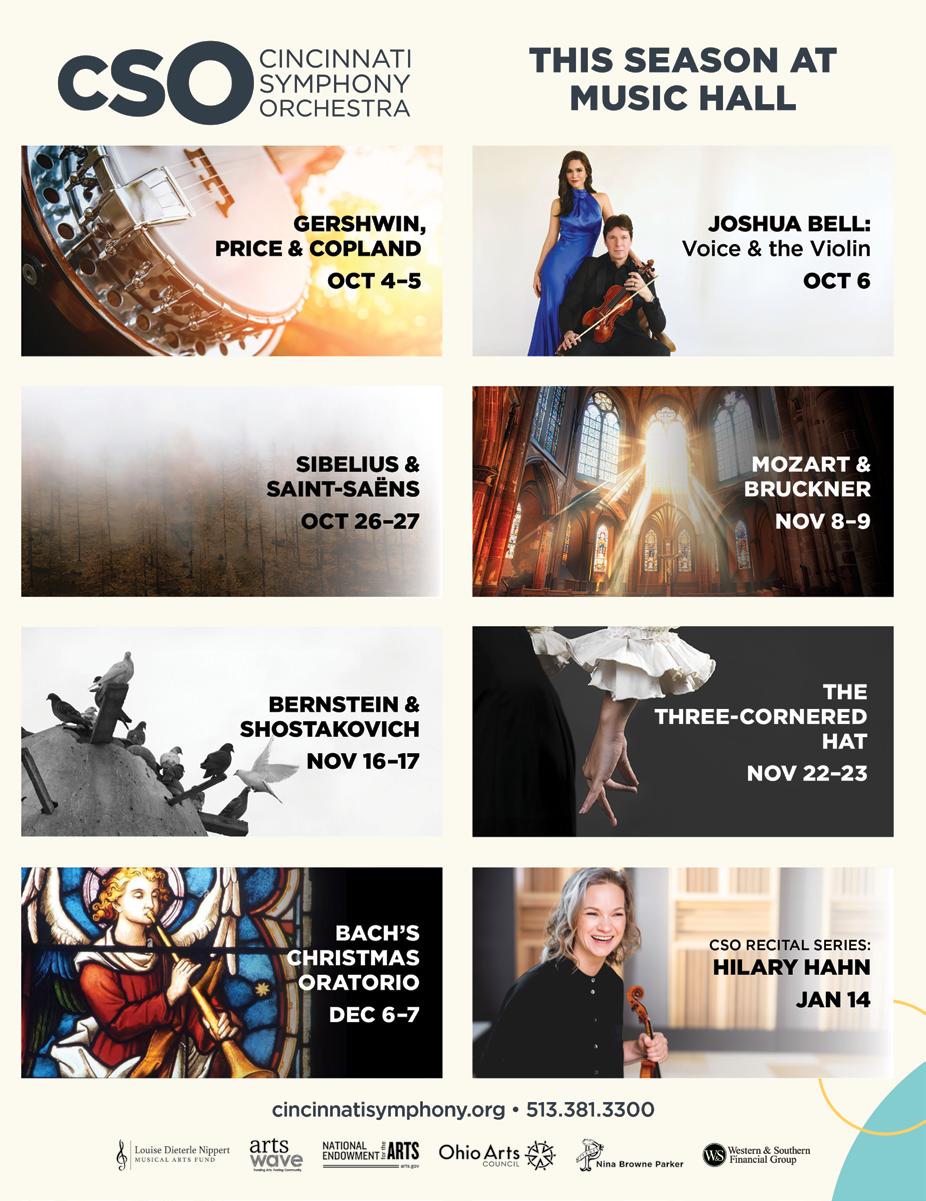
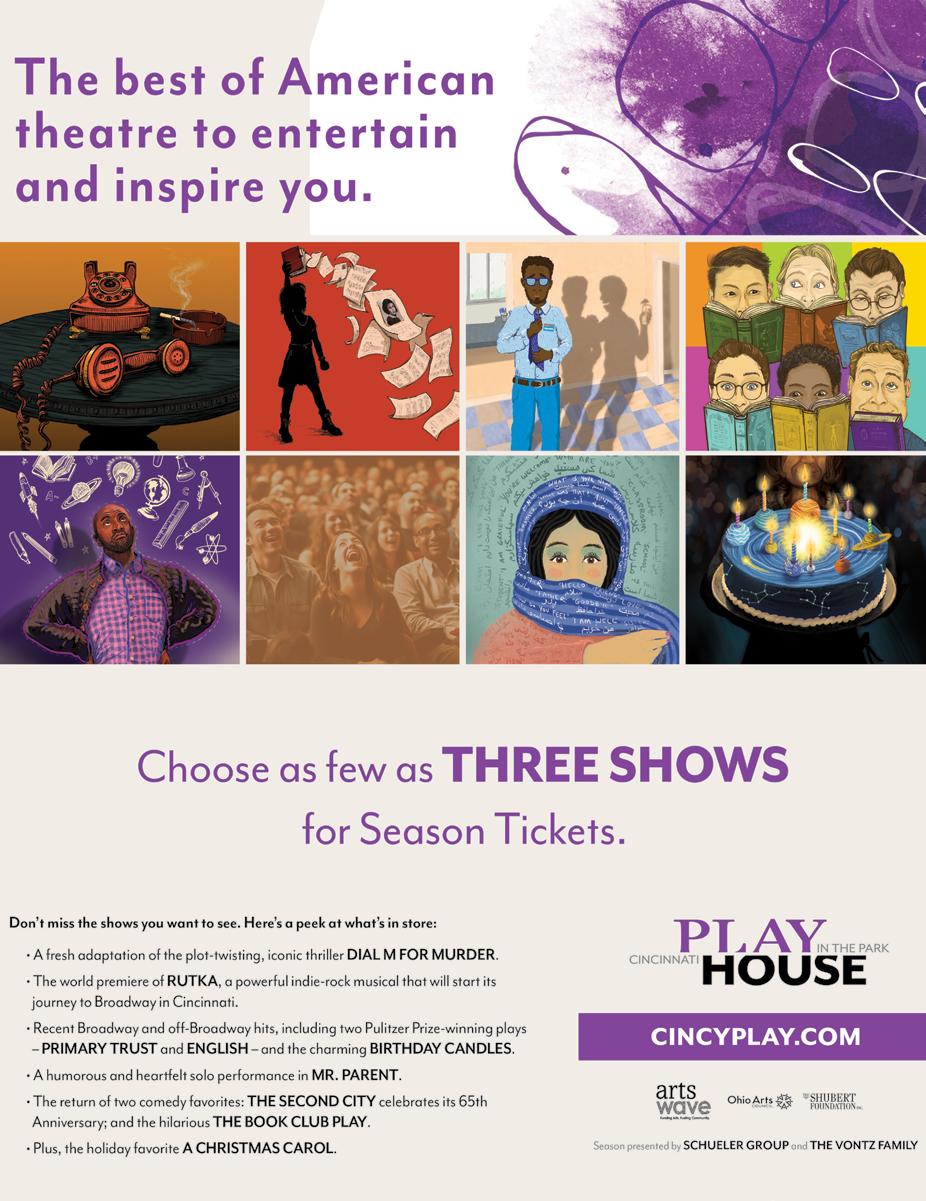
BY LOGAN TURNER
There are several events that highlight Cincinnati’s ever-expanding art scene. From BLINK to the Cindependent Film Festival, the Queen City consistently showcases why it’s one of the premier art towns in America. One of Cincinnati’s most popular art events is the FotoFocus Biennial, a series of events that highlights the art of photography both from around the country and locally.
FotoFocus is a nonprofit based in Cincinnati. The group was established in 2010 and focuses on supporting lens-based art through several events, programs and grants it awards to institutions supporting educational and presenting opportunities. According to their website, their mission statement is “to present and support photography and lens-based projects that are accessible, enriching, and engaging to a diverse public.”
The Biennial itself is a massive event. It spans a month, with the opening weekend happening Sept. 26-28. The series of events that make up the FotoFocus Biennial take place across 87 venues in Cincinnati, Dayton, Columbus and Northern Kentucky. These various venues will play host to 107 different projects. The sheer number of projects and venues makes this the biggest event in the history of the program.
Exhibitions in this year’s FotoFocus Biennial include Discovering Ansel Adams, a display of the early works of the famous photographer at the Cincinnati Art Museum where viewers will have a chance to dissect his images in a new light. Another exhibition at the Contemporary Arts Center will showcase the work of photographer Chip Thomas and his attempt to document marginalized communities in Nothern Arizona.
All this to say that Greater Cincinnati is about to host one of the largest photography events in the country. Given the sheer magnitude of the FotoFocus Biennial, Katherine Ryckman Siegwarth, the nonprofit’s executive director, and Kevin Moore, the artistic director and curator at FotoFocus, sat down with CityBeat to explain what the Biennial is all about and what visitors can look forward to this year.
“It’s a way to bring high-quality exhibitions to Cincinnati,” Moore says of the
FotoFocus Biennial. “We so far rely on host institutions like CAC (Contemporary Arts Center), the (Cincinnati) Art Museum and Taft (Theatre) for our own original programming, but it’s also a very democratic event in a sense that we fund over a hundred-plus organizations throughout the region to organize and present photography exhibitions as well.”
Some of the exhibitions being showcased during the Biennial feature some of photography’s most distinguished artists, including Ansel Adams, Chip Thomas and Barbara Probst. The Biennial will also showcase several Cincinnati photographers who submitted works through FotoFocus’ call for submissions, including Mark Albain, Racheal Banks and Asa Featherstone.
With so many different projects, artists and venues FotoFocus worked alongside a list of different curators to better manage the amount of time and manpower the Biennial requires. Siegwarth explained how the nonprofit was able to pull such a feat off.
“Well, Kevin and I are incredibly fortunate to work with incredible people,” Siegwarth says. “The FotoFocus team is about 10 in total so we’re a lean and mean team, but we have an incredibly attentionorientated, type A, Excel spreadsheet-type team. It also helps that this is our seventh iteration. We have a lot of repeat venues who know how this works and remain dedicated and excited so it gets a little easier each time.”
Despite the scope of the month-long showing, all of the exhibitions are brought together by one central theme: backstories According to the FotoFocus website, the theme of backstories is summarized as, “referring to past experiences that may have happened out of view or gone unnoticed — histories that have not been told or have lacked perspective. These stories fill in the possible blanks, providing essential context for art and images.” Moore spoke more on the theme and how it played out in this year’s event.
“‘Backstories’ is a theme that relates to this idea of a single photograph as a complete story,” Moore says. “There’s so much more going on than that one instant, than that one photograph can sort of try and sum up a story, but I think we’ve also
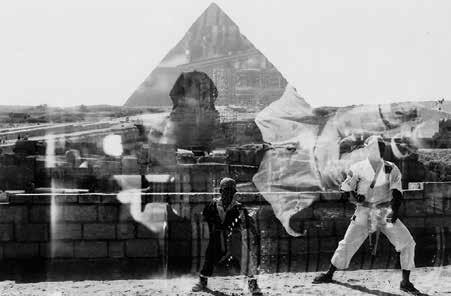
become aware that we need more context for most of what we see and hear.”
Moore also spoke about how a theme typically is a way to bring a large chaotic event together in a coherent way. Having this theme will ensure that guests who visit the multiple exhibitions will feel that sense of unity among the different showings. Siegwarth spoke to CityBeat about what guests can expect during this year’s FotoFocus Biennial.
“We do have our opening program weekend; that’s Sept. 26-28,” Siegwarth says. “That’s our way of celebrating and grounding the theme of the Biennial. We have several exhibition receptions and gallery tours. Kevin has worked on creating a symposium that we’re hosting on the 28th at Memorial Hall. That will have a lot of great speakers. Another aspect of the Biennial is we have a passport program. This is a way for people to participate and attend all of our 107 projects for free. Most of them are free to the public, some do have charges. If you sign up for our passport you receive invitations to all of our receptions and events — access to that opening program weekend and the ability to attend all venues for free during the month of October.” The 2024 FotoFocus Biennial Passport is free and can be accessed on FotoFocus’ website.
Siegwarth mentioned that FotoFocus will also be hosting a bus tour. This will
give people a chance to be commuted to participating venues. This even includes the venues in far-off Columbus. You can learn more about the bus tours on the FotoFocus website, or visit artistruncincy. com/tour. Moore also stated that the artists themselves will be accessible to the public so that the audience can converse and mingle with those involved in the show. Although there are no formal meet and greets, Moore expects many featured artists to be there the day of their respective events and actively participate in open discussions about the pieces.
Siegwarth also encouraged people to simply show up for the Biennial to continue to support not just their nonprofit, but all the participating venues, artists and curators.
To learn more about the individual events and schedule of programs included in the FotoFocus Biennial, visit FotoFocus’ website.
“We do great shows. We do great events. They’re very engaging; they’re fun. It doesn’t feel like something you should do for cultural edification. It’s actually something entertaining, interesting and social.”
The FotoFocus Biennial runs from Sept. 26-Oct. 25 at various locations throughout Northern Kentucky and Ohio. More info: fotofocus.org.
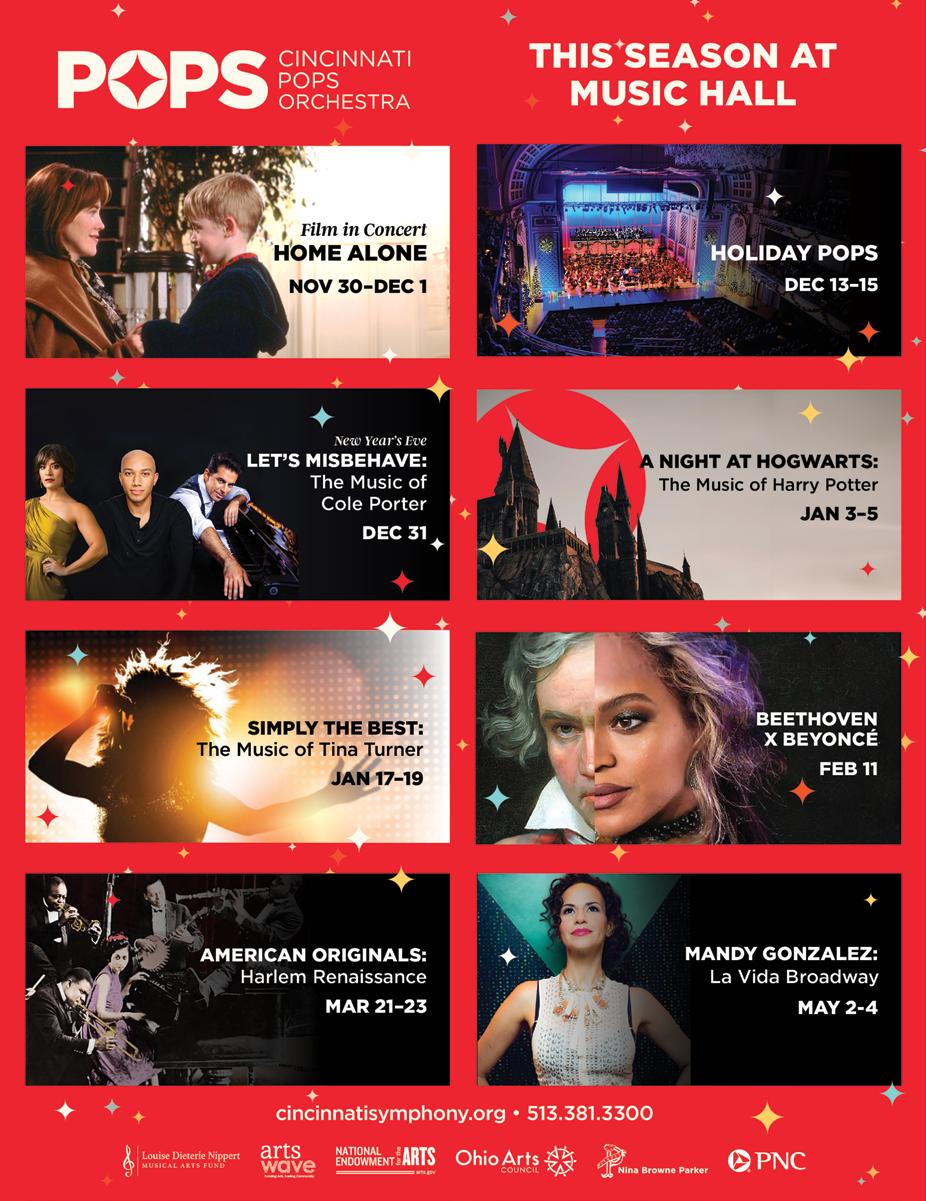
BY NOAH MOORE
will satisfy your needs. The show is told in two explosive acts, set 50 years apart, and follows one Black family planting roots and later efforts to unearth them, as gentrification takes hold. This riveting drama runs Sept. 5-22, directed by Dan Maloney.
If you’re looking to laugh, there’s no shortage of hilarious works opening this fall across the city. Cincinnati Playhouse in the Park puts comedy on full blast in The Second City, the 65th anniversary tour of the titular sketch comedy series. Boasting alumna such as Tina Fey and Catherine O’Hara, witness one of the most influential

Like every good harvest table, this fall’s theater offerings in Cincinnati have a little bit of everything, whether you want to laugh or cry, sing or scream. The city of Cincinnati, named by Carnegie Mellon University’s College of Fine Arts in 2022 as one of the nation’s most artistically vibrant cities, has a thriving theater scene, from regional theaters to universities to community players. Of course, with so many options, it’s important to siphon down what you’re looking for. So, look no further — here’s just a sampling of productions hosted by Greater Cincinnati theater companies this fall.
For the dramatist
One of the high profile premieres this fall is Cincinnati Playhouse in the Park’s Rutka: A New Musical. Billed as Broadway-bound, this musical is based on the real-life diary of 14-year-old Rutka Laskier, a Jewish girl living in 1943 Poland. Through indie rock music by Jocelyn Mackenzie and Jeremy Lloyd-Styles, the teenage experience is told through one specific lens amidst the atrocities of World War II. The show premieres
Oct. 13 and runs through Nov. 10.
Also in a similar time period is the Know Theatre’s Camp Siegfried by Bess Wohl, author of Grand Horizons, which premiered at Ensemble Theatre Cincinnati last season. The play takes place in 1938 at a summer camp for far-right indoctrination, as two German-American teenagers fall in love. Know Theatre kicks off its first season under new artistic director Bridget Leak, with the show running Sept. 13-28 at the Know Theatre in Over-the-Rhine.
You can find more modern fare in Northern Kentucky University’s production of The Wolves by Sarah Delappe, running Oct. 24 to Nov. 3 at the Fifth Third Bank Theater in the Aronoff Center downtown. Following the members of a high school women’s soccer team, this acclaimed play balances the innocence of the teenage years with the mundane reality of suburban America. It is also an entirely-female play that can satisfy your post-Olympics sporting needs with less yelling.
For lovers of social commentary, Bruce Norris’ Tony- and Pulitzer-winning play, Clybourne Park, at the Mariemont Players,
legend of a Loveland frog whose reputation precedes it. When a community outcast disappears, the hysteria over the titular frog brings together a rag-tag team of Cincinnati stars for a hilarious romp on a local legend. The show runs Sept. 5-7 at the Loveland Stage Company. For the musical lover
The iconic rock opera Jesus Christ Superstar comes back to Cincinnati in Xavier University theater’s upcoming production. With music by Andrew Lloyd Webber, the show follows the final chapter of Jesus’ life through a sleek, gritty lens and features some earworm hit songs, from the titular number to “I Don’t Know How to Love Him ” The show runs Oct. 11-20 at Xavier University’s campus theater.
If you’re on a religious musical kick, look no further than Nunsense at Covedale Center for the Performing Arts. This satire follows a group of nuns raising funds for their convent after bouts of leprosy and food poisoning…reduced their numbers. With a hilarious score and audience interaction, this will be a fun night at the theater, running Sept. 12 to Oct. 6. One of the best combinations of comedy and classic musicals is The Drowsy Chaperone, which opens Sept. 19 and runs through Oct. 6 at The Footlighters in Newport, Ky. Since its 2006 acclaimed premiere, this show has captivated audiences with its musical-within-a-musical hilarity and wacky characters. The show opens Footlighters’ 2024-2025 season, as a community theater with over 60 years of history making theater in the area.
comedy shows in its tour stop in Cincinnati from Oct. 24 to Dec. 22.
Premiering fresh off its Tony-nominated Broadway premiere, James Ijames’ Fat Ham, a modern retelling of Hamlet set at a backyard barbecue in the deep south, premieres at Cincinnati Shakespeare Company this fall. The hilarious and heartfelt show balances laugh-out-loud moments with tender commentary on Black and queer identity, and runs Sept. 6-22 at Cincy Shakes’ Over-the-Rhine theater.
Ensemble Theatre Cincinnati premieres
The Garbologists by Lindsay Joelle Sept. 14 to Oct. 6. Following two garbage truck workers with differing pasts, we see that one man’s trash is another man’s treasure and we have more in common than we assume. Despite the title, this two-person dramedy promises fresh storytelling, in line with ETC’s emphasis on new works.
For laughs that fall a bit closer to home, check out the Loveland Stage Company’s comedy-musical, Hot Damn! It’s the Loveland Frog! An original musical by Cincinnati natives Michael D. Hall and Joshua Steele, this show follows the eponymous
University of Cincinnati’s College-Conservatory of Music will stage a new musical, In The Green, this October. The newer one-act musical by Broadway performer Grace McLean tells the story of Hildegard of Bingen, who would become a famous composer and activist. With themes of recovery, discovery and sexual assault, you can expect a deep-cutting but profoundly unique musical experience.
Nothing rings in spooky season like a chilling play, and Cincinnati Shakespeare Company has you covered with Mary Shelley’s Frankenstein, running Oct. 11 to Nov. 2. Billed as a new spin on the classic story, Frankenstein is alive and raises the question of who the true monster is in this spine-chilling production.
You can’t forget about witches, and The Carnegie along with UC-CCM are here to remind you in their fall staging of Witch by Jen Silverman. Complementing UC-CCM’s previous thriller, Let The Right One In, this show follows the arrival of a devil to a quiet English town. There’s soul-bargaining and passion flaring in this co-production between two strong community arts organizations at the Carnegie in Covington, Ky.
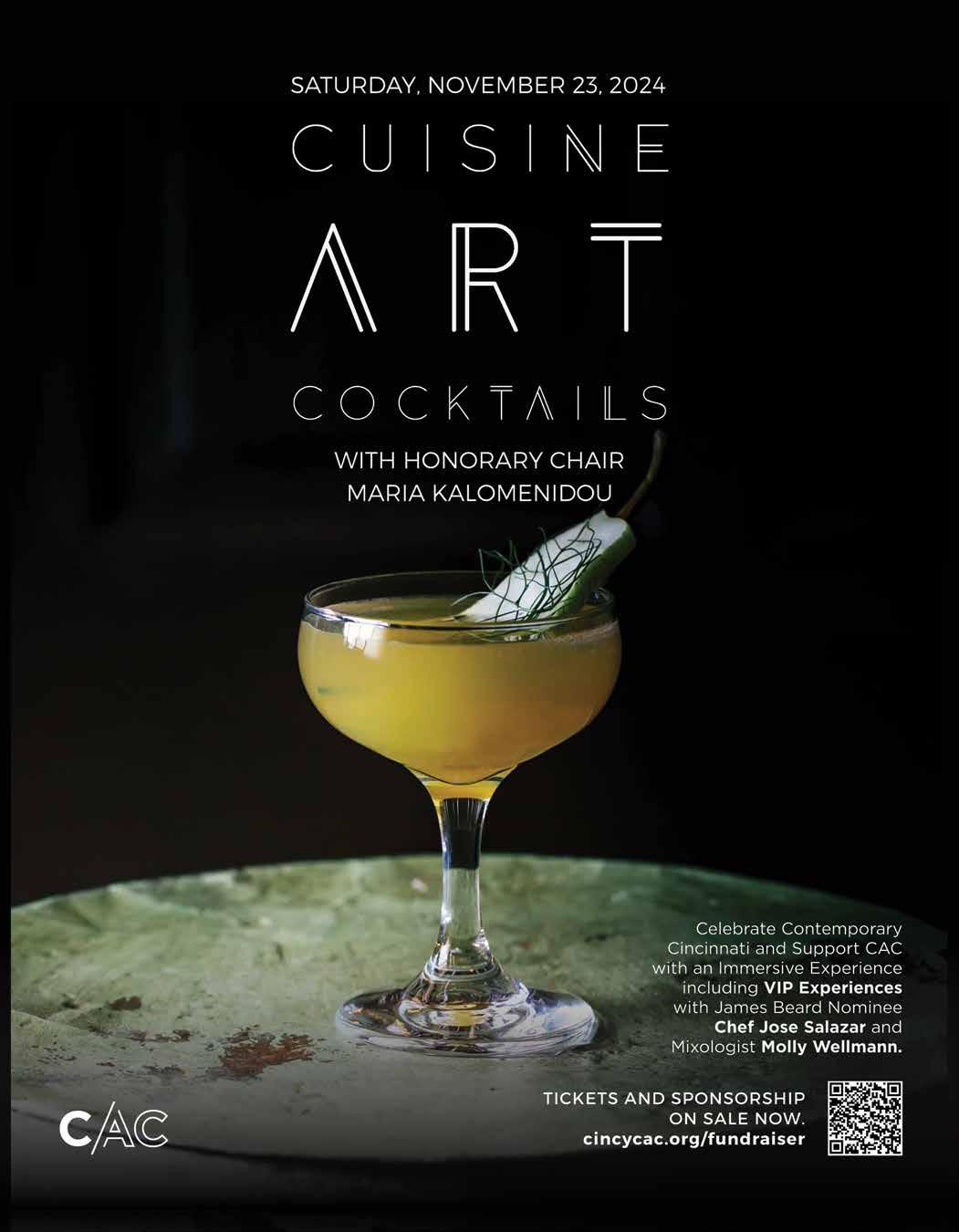

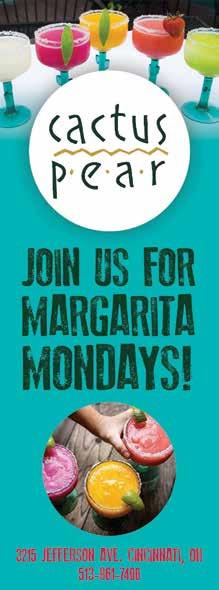



BY ANNE ARENSTEIN
When conductor Louis Langrée departed last May, he left the Cincinnati Symphony Orchestra (CSO) at the top of its game — a supple, flexible ensemble whose performances of contemporary works were often as thrilling as those of symphonic warhorses.
The CSO’s 2024-25 season reflects the orchestra’s stature as it anticipates the arrival of Music Director Designate Christian Măcelaru, who arrives in February.
The fall season has plenty of star power, bolstered by a commitment to musical excellence, experimenting with formats and offering more contemporary music.
The lineup features acclaimed conductors Marin Alsop, Jaap van Zweden, and Sir Donald Runnicles. Banjo virtuoso Béla Fleck and violin phenom Randall Goosby are among 20 soloists. Smaller scale offerings are the always intriguing CSO Proof series, along with chamber and solo recital concerts.
Finnish conductor Dalia Stasevska returns on Sept. 27, conducting Mahler’s Symphony No. 1 and Prokofiev’s Piano Concerto No. 3 with pianist Bruce Liu. Stasevska holds major posts in England and Europe and last season, she led a powerful performance of Sibelius’s Symphony No. 5.
American music is center stage the following weekend with one of its leading exponents, Fleck, making his CSO debut, performing his arrangement of Gershwin’s Rhapsody in Blue, led by Thomas Wilkins.
Fleck is no stranger to western classical music or to the concert stage. His 2001 release Perpetual Motion won a Grammy for best classical crossover and Fleck has performed his Juno Concerto with major orchestras.
CSO President Jonathan Martin and Anthony Paggett, vice president for artistic planning, both use the word “magical” when describing Fleck and the program.
“He’s a consummate artist,” says Martin. “There’s a handful of people who can make that instrument sound magical.”
“There’s something magical about playing Copland’s ‘Hoedown’ followed by Béla playing Rhapsody in Blue on the banjo,” Paggett adds.
Alsop arrives in November to lead the

CSO in Shostakovich’s Symphony No. 7 (Leningrad) and Bernstein’s “Chichester Psalms” with the May Festival Chorus.
Bernstein was Alsop’s mentor, one of his last students, and she has championed his music throughout her career.
The May Festival Chorus returns for CSO’s holiday offering, Bach’s Christmas Oratorio, led by British conductor Richard Egarr, former music director of the Academy of Ancient Music. Soloists are soprano Joélle Harvey, mezzo Jennifer Johnson Cano, tenor Paul Groves and bass John Relyea.
CSO’s first-chair musicians are featured soloists beginning in January when cellist Ilya Finkelshteyn plays Saint-Saëns’ Cello Concerto No. 1, led by Christian Reif. The following week, principal horn Elizabeth Freimuth performs Strauss’s Horn Concerto No. 1, led by Jun Märkl.
Măcelaru takes the podium on Feb. 8, 2025, with two audience favorites: Dvořák’s New World Symphony and violinist Goosby playing Price’s Violin Concerto No. 3.
“Randall will eat it alive!” exclaims Martin.
The season concludes in May with Pops Principal Guest Conductor, Damon Gupton, making his CSO debut leading a witty mashup of Honegger, Stravinsky, Dvořák and Ellington.
“The musicians love him!” says Martin. “His availability is so limited because of his acting career, so we’re delighted to have him end the season and that program is super tasty!”
CSO Proof offers two intriguing programs, beginning in Oct. 16 with Aureliano Cattaneo’s 2020 work La Nuit Sombre that ties in perfectly with the season’s supernatural weirdness and phantasmagoria. Written for two women’s voices and a spatial ensemble led by CSO’s creative partner Matthias Pintscher, the text is based on a novel by Polish Count Jan Potocki.
“It’s intertwined Arabian Nights stories set in Spain,” Paggett explains. “Potocki’s obsessed with secret societies, masks and the supernatural.”
The musical material is an improbable encounter with Mozart.
“The music is meant to interweave with Mozart’s Serenade No. 10, the Gran Partita, and isn’t altered in any way but interspersed with movements of new musical material and introduced with new musical material,” Paggett says.
“It’s a completely different soundscape,” he continues. “When you hear it all the way through, there’s an interesting aural connection. We’re leaning into that mysterious vibe and we’re encouraging the audience to wear costumes and masks.”
The spring Proof concert on March 27
is Tango Lab, designed to be part concert and part learning experience.
World-renowned artists present solo recitals throughout the season, beginning with violinist Joshua Bell and his wife, soprano Lisa Martinez on Oct. 6. The program includes works by Mendelssohn, Bernstein, Puccini and more.
“Josh is an audience favorite and Lisa is a wonderful soprano who’s toured with Andrea Bocelli,” says Martin. “People will come for Josh Bell but will leave saying ‘Holy moly!’ when they hear her.”
The great three-time Grammy-winning violinist Hilary Hahn gives a solo recital of Bach works in January, marking a welcome return after an eight-year absence.
Pianist Conrad Tao’s solo recital in March features his arrangement of “Over the Rainbow,” along with works by Debussy, Schumann and Tao himself. Four chamber concerts throughout the season extend far beyond the string quartet, with programs curated by CSO musicians and others at each performance. The first concert is Sept. 24 and includes Claude Bolling’s classic Suite for Flute and Jazz Piano.
Although this is a transition season, planning began more than a year and a half ago. Guest conductors, soloists, Langrée himself and CSO musicians were involved in creating formats and choosing music.
No matter how careful the planning, the logistics were daunting.
“If you’re going to be without a music director for ten weeks, you want to make sure to craft programs that the ensemble can sink its teeth into with great conductors like Marin Alsop and Jaap van Zweden,” says Martin.
A major program shift followed the death of conductor Sir Andrew Davis in April. Davis was scheduled to conduct his edition of Handel’s Messiah in December. Bach’s Christmas Oratorio was an ideal substitute with the same vocal and choral forces.
Martin calls the season “weighty.”
“It’s thick in a good way and that was very much by design,” he says. “There’s really something for everybody.”
For more information about Cincinnati Symphony Orchestra’s 2024-25 season, visit cincinnatisymphony.org.
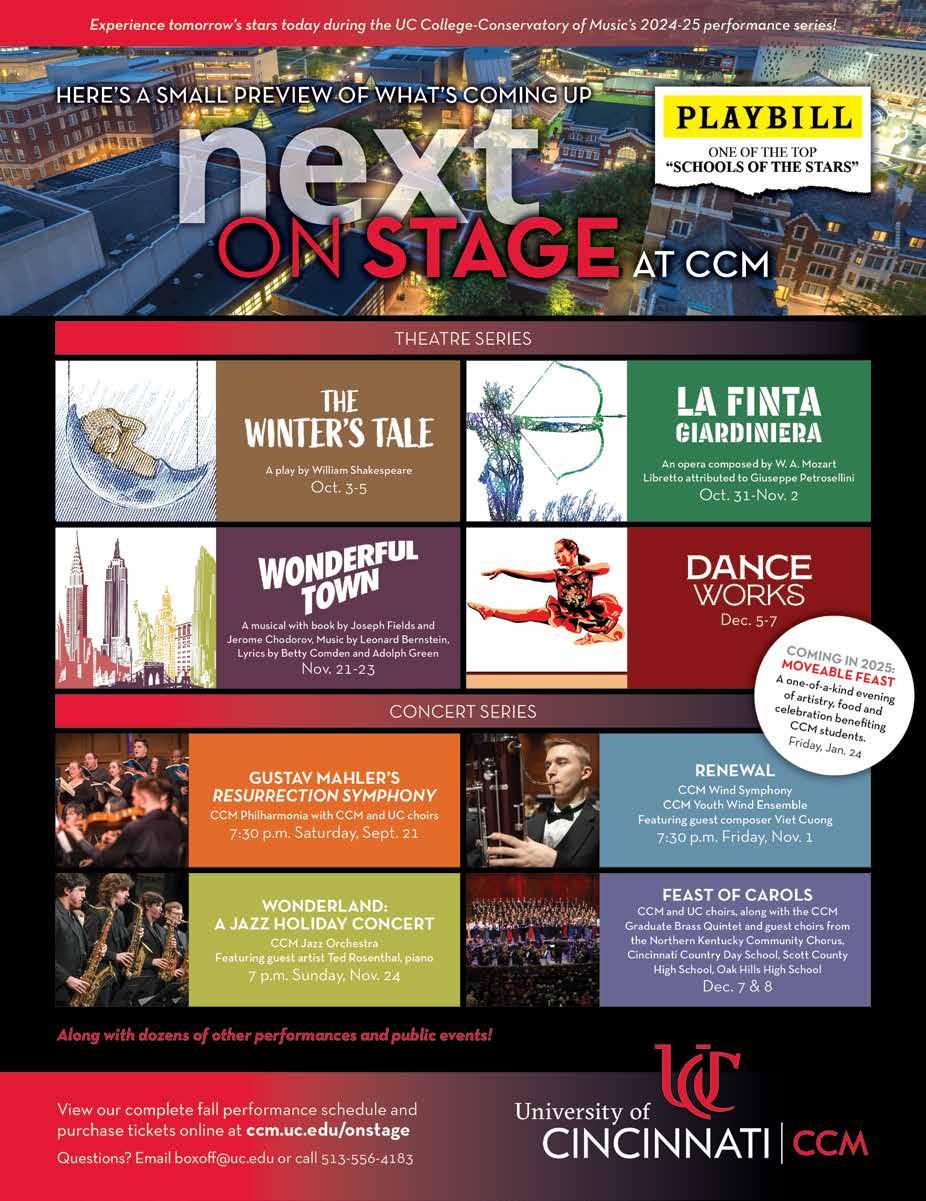
BY EMMA HELBLING
The Greater Cincinnati area is a melting point for all things visual arts. From various galleries and large museums to nonprofit organizations and universities showcasing their work, there is a wide range of mediums and topics represented. This fall, Cincinnati welcomes a fresh lineup of visual arts exhibitions and performances you don’t want to miss.
The Cincinnati Art Museum (CAM) is one of Cincinnati’s largest centers for all things visual arts, featuring various rotating exhibits throughout the year as well as occasional performances to accompany them. This fall, CAM will welcome Discovering Ansel Adams, running from Sept. 27 to Jan. 19. The exhibit explores the early career of Ansel Adams, one of America’s most celebrated photographers, and the progression of his career ranging from the early 1900s through the 1940s. Alongside 80 of Adams’ photographs, the exhibit hosts personal possessions, handwritten correspondence and more. The exhibit is in collaboration with the Adams collection at the Center for Creative Photography in Tucson.
CAM will also showcase George Bellows: American Life in Print, running from Oct. 25 to Feb. 9. The exhibit commemorates the 100th anniversary of the passing of George Bellows, an Ohio-native painter, illustrator and printmaker. Fiftyfive lithographs and drawings of Bellows’ family, snapshots of American life and atrocities of World War I will be featured to showcase Bellows’ 20-year career in which he helped elevate lithography to a fine art. If you’re looking for a more interactive option, ArtWorks, a local nonprofit creating accessible community art, hosts mural tours highlighting various parts of the Greater Cincinnati area. ArtWorks holds various tours throughout the fall season, with the first being held on Sept. 7. These tours are held in the downtown, Over-the-Rhine and Walnut Hills areas — depending on your interest — and explore up to 13 fan-favorite murals and the artists
is a collection of videos, photographs and other mixed-media pieces that showcases members of the performance collective as they traveled the world and walked the streets as green characters. The exhibit displays the struggles they faced during this experience, related to racism, sexism, beauty standards and mental health issues.
If you’re looking to plan a trip downtown, the Contemporary Arts Center (CAC), which lies in the heart of Cincinnati’s Central Business District, is a must-see. This fall, they are welcoming their newest photography exhibition, Barbara Probst: Subjective Evidence, which showcases the work of the well-known German
and working artists is finishing up its 20th exhibition season, and is currently showcasing NUDE: Exploring the Uncovered Human Form, through Sept. 13. This 16th-annual exhibition features a gallery of 23 works submitted by artists internationally exhibiting how the human body is used today in art. Additionally, Manifest Gallery is hosting EYES and HAIR through Sept. 13. Each exhibit features a collection of work selected by a blind jury of artist-submitted work representing the power and complexity of eyes and hair when removed from the human body.
Over-the-Rhine’s Solway Gallery is welcoming John E. Dowell: Pathways To Freedom, in collaboration with the

and histories behind them. Each tour lasts about two hours and spans two miles.
Cincinnati art schools and universities are also using this season to showcase their work and collaborations you don’t want to miss out on. The University of Cincinnati’s College of Design, Architecture, Art and Planning (DAAP) will welcome the Still Moving exhibition to their Reed Gallery from Sept. 12 through Nov. 21. The exhibit serves as a platform to showcase immigrant and refugee communities and the impact they have made in Cincinnati through photographs, prints and written narratives. The exhibit allows these individuals to explore their complex histories and the impacts they have made.
The Art Academy of Cincinnati, a private college of art and design in Cincinnati, is collaborating with FotoFocus this fall to present Humphrey Gets His Flowers, running from Sept. 27 through Nov. 1. The exhibition, created by Mute-NHeard and its founder Michael Coppage,
photographer’s 25-year career. CAC will display a variety of Probst’s work from landscapes and still lifes to portraiture and street photography, emphasizing the ability and range of her photographic work. CAC will host an opening ceremony for the exhibit on Sept. 27, with an afterparty at Alice OTR.
This fall, CAC will be collaborating with the Zonta Club of Cincinnati — a local nonprofit that aims to improve the lives of women and girls locally and worldwide — to present Journey of Healing: The Trauma-Informed Power of Art. The exhibition will run from Oct. 10-27, with an opening ceremony on Oct. 10, and will showcase drawings, paintings, photographs and prints that represent healing from domestic violence and the holistic use of art as a healing modality.
Alongside larger museums, Cincinnati is home to various art galleries welcoming new exhibits this fall. Manifest Gallery, a nonprofit operated by professors, students
FotoFocus Biennial, opening Sept. 19. Solway Gallery, located in a historic warehouse, is home to various contemporary art mediums such as paintings, sculptures and video/electronic pieces. Their newest gallery this fall features a series of photographs representing Dowell’s spiritual revelations through the symbolic history of the cotton field.
The Weston Art Gallery, also in collaboration with the FotoFocus Biennial, will be presenting its newest exhibition Rachael Banks: The Trail of the Dead from Sept. 20 through Nov. 3. The exhibition will showcase the photographic work of the Newport, Ky. native. The Weston Art Gallery, located just outside of Fountain Square, hosts a variety of rotating exhibits and dedicates its gallery spaces to local and regional artists. The exhibition explores Banks’ intergenerational trauma within her family, as well as the complexity of loss and addiction and their lasting impacts.
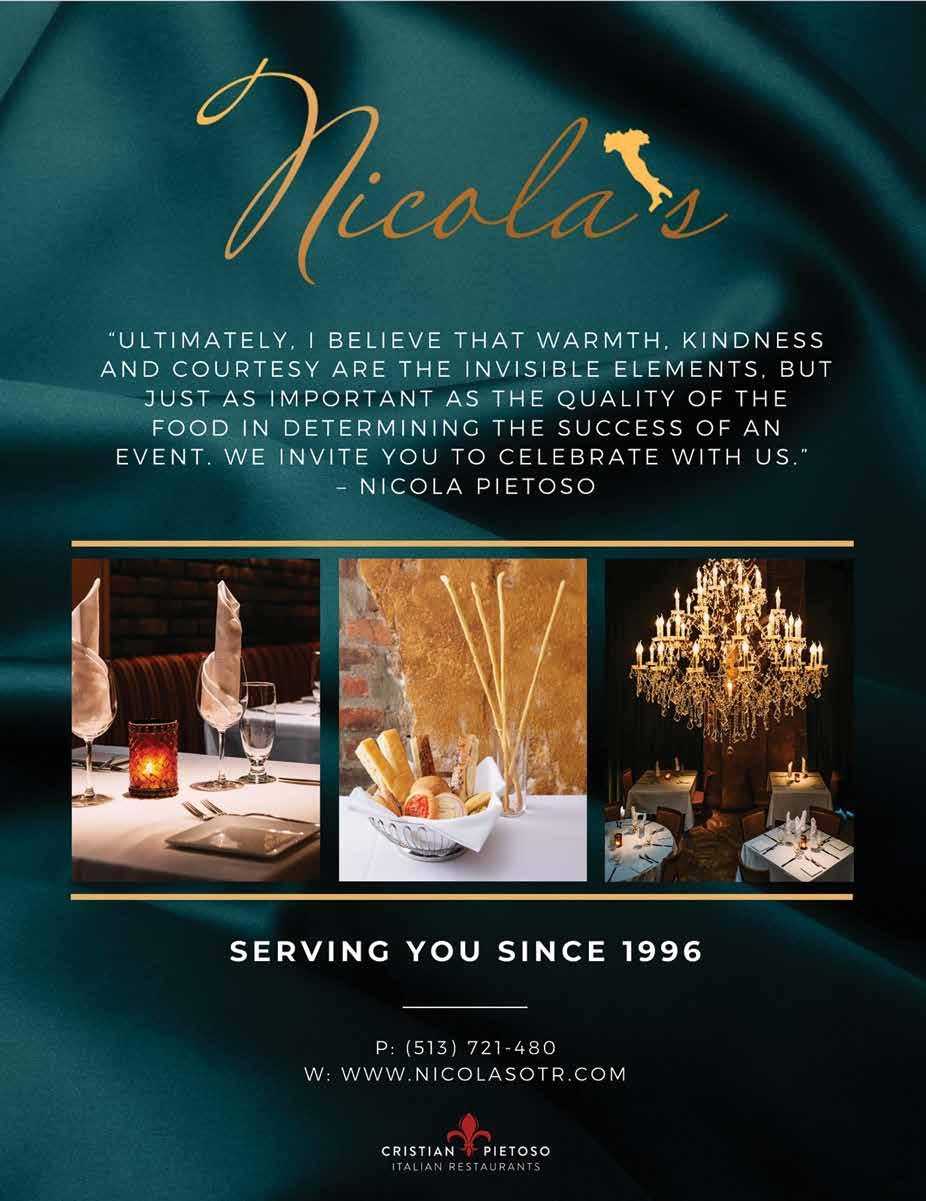



BY STEVEN ROSEN
Bill Maher talks Kamala Harris, J.D. Vance and more ahead of his upcoming Cincinnati show
BY STEVEN ROSEN
BBill Maher’s style of sharp humor mixed with sometimes angrily impassioned commentaries on our state of affairs has been a mainstay of talk-show television for 34 years — first on Politically Incorrect and, since 2003, on HBO’s Real Time with Bill Maher
ill Maher’s style of sharp humor mixed with sometimes angrily impassioned commentaries on our state of affairs has been a mainstay of talk-show television for 34 years — first on Politically Incorrect and, since 2003, on HBO’s Real Time with Bill Maher. He causes plenty of controversy with his often-iconoclastic views that challenge the comfort zone of even his keenest followers. But he also has a devoted following that turns out for his live stand-up shows, such as the one on Sept. 29 at Taft Theatre.
He causes plenty of controversy with his often-iconoclastic views that challenge the comfort zone of even his keenest followers. But he also has a devoted following that turns out for his live stand-up shows, such as the one on Sept. 29 at Taft Theatre.
Don’t be surprised if his antipathy to Donald Trump shows up in his presentation here. The Republican is running for president again after refusing to accept that he lost his 2020 bid at reelection. Maher on his TV show and elsewhere was an early warning system after Trump was elected to the presidency in 2016, saying Trump would never accept it if he lost reelection in 2020, which he did. Now Maher fears returning Trump this year could be a death knell for democracy.
Don’t be surprised if his antipathy to Donald Trump shows up in his presentation here. The Republican is running for president again after refusing to accept that he lost his 2020 bid at reelection. Maher on his TV show and elsewhere was an early warning system after Trump was elected to the presidency in 2016, saying Trump would never accept it if he lost reelection in 2020, which he did. Now Maher fears returning Trump this year could be a death knell for democracy.
“I’m never cagy or coy about what I think is the priority, which is that Trump not be reelected,” Maher says in a phone interview with CityBeat “There’s no doubt about it that the right wing is more dangerous because they simply don’t concede elections. And everything follows from that. You have to concede elections because that’s what makes America, America — the peaceful transference of power. So everything comes second to that. I’ll vote for anybody who isn’t Donald Trump.”
“I’m never cagy or coy about what I think is the priority, which is that Trump not be reelected,” Maher says in a phone interview with CityBeat. “There’s no doubt about it that the right wing is more dangerous because they simply don’t concede elections. And everything follows from that. You have to concede elections because that’s what makes America, America — the peaceful transference of power. So everything comes second to that. I’ll vote for anybody who isn’t Donald Trump.”
Maher also has been quite critical of the progressive wing of the Democratic party for what he believes is its excessive attention to political correctness. While that criticism perhaps ought to have been expected, given the name of one of his television shows, it surprised many who thought he was all in for Democrats.
Maher also has been quite critical of the progressive wing of the Democratic party for what he believes is its excessive attention to political correctness. While that criticism perhaps ought to have been expected, given the name of one of his television shows, it surprised many who thought he was all in for Democrats.
But, Maher says, he considers himself an “old-school liberal.” He further explains, “I’ve never said I’m a Democrat,” he says, but then qualifies. “I’ve voted for them almost always, because
But, Maher says, he considers himself an “old-school liberal.” He further explains, “I’ve never said I’m a Democrat,” he says, but then qualifies. “I’ve voted for them almost always, because
I look at both candidates and almost always the Democrat is more common sense and practical, even now.”
I look at both candidates and almost always the Democrat is more common sense and practical, even now.”
“The far left does not really reflect the Democratic politician so much,” he continues. “Take something like (the recent issue of) defunding the police. That was a big thing on the far left. Most Democratic politicians didn’t support it.”
“The far left does not really reflect the Democratic politician so much,” he continues. “Take something like (the recent issue of) defunding the police. That was a big thing on the far left. Most Democratic politicians didn’t support it.”
Maher arrives in Cincinnati with a recently published best-selling book, What This Comedian Said Will Shock You. The chapters are based on the editorials he gives at the end of each Real Time and bear such titles as “Free Speech,” “Cops,” “Religion,” “Guns” and “Race.” In the phone interview, Maher explained his complex thoughts on gun control with CityBeat
Maher arrives in Cincinnati with a recently published best-selling book, What This Comedian Said Will Shock You. The chapters are based on the editorials he gives at the end of each Real Time and bear such titles as “Free Speech,” “Cops,” “Religion,” “Guns” and “Race.” In the phone interview, Maher explained his complex thoughts on gun control with CityBeat.
“I think it is an elitist position that far-left liberals take about guns,” he states. “They don’t take into account that, yeah, they live in nice neighborhoods where the police come quickly, where they don’t have to worry about people robbing them or accosting them. There are people who actually need guns to protect themselves or people out in the wilderness.”
“I think it is an elitist position that far-left liberals take about guns,” he states. “They don’t take into account that, yeah, they live in nice neighborhoods where the police come quickly, where they don’t have to worry about people robbing them or accosting them. There are people who actually need guns to protect themselves or people out in the wilderness.”
But there is a problem with the love of guns, Maher says, and it troubles him. “The idea we worship guns, that we want to play with them, that we want to put them on our Christmas cards or we want to wear them out in public when you’re going to Chipotle or Home Depot — there’s something sick about that.”
But there is a problem with the love of guns, Maher says, and it troubles him. “The idea we worship guns, that we want to play with them, that we want to put them on our Christmas cards or we want to wear them out in public when you’re going to Chipotle or Home Depot — there’s something sick about that.”
When this interview occurred on Aug. 12, only three weeks had passed since President Joe Biden had withdrawn from seeking a second term and endorsed Vice President Kamala Harris to replace him. By Aug. 12, the overwhelmingly positive reception from Democrats to Harris had turned her public appearances into popconcert-like celebrity events, and New York Magazine even coined the term Kamalot to describe her impact. (It’s a reference to “Camelot,” a term used in the early ‘60s to describe President John F. Kennedy’s spellbinding hold on the nation’s imagination.)

these fast-breaking events and where he thought Harris might be when he performs at the Taft Sept. 29. “As someone who a year ago was imploring Biden to get out of the race, I’m glad that finally happened and I’m glad to see we have a competitive race now,” he replies. “It almost doesn’t matter what I think about Kamala Harris because I don’t want Trump to be president.
these fast-breaking events and where he thought Harris might be when he performs at the Taft Sept. 29. “As someone who a year ago was imploring Biden to get out of the race, I’m glad that finally happened and I’m glad to see we have a competitive race now,” he replies. “It almost doesn’t matter what I think about Kamala Harris because I don’t want Trump to be president.
things, like the ‘Cat Lady’ thing,” he answers.
things, like the ‘Cat Lady’ thing,” he answers.
“I kind of take it personally,” Maher explains. “As someone who for decades on television has made the case for single people, I think I had a small part in making this mainstream. It’s just a different lifestyle choice; it doesn’t mean we’re morally inferior because we don’t want to have a family.
“I kind of take it personally,” Maher explains. “As someone who for decades on television has made the case for single people, I think I had a small part in making this mainstream. It’s just a different lifestyle choice; it doesn’t mean we’re morally inferior because we don’t want to have a family.
Maher was asked what he thought of
When this interview occurred on Aug. 12, only three weeks had passed since President Joe Biden had withdrawn from seeking a second term and endorsed Vice President Kamala Harris to replace him. By Aug. 12, the overwhelmingly positive reception from Democrats to Harris had turned her public appearances into popconcert-like celebrity events, and New York Magazine even coined the term Kamalot to describe her impact. (It’s a reference to “Camelot,” a term used in the early ‘60s to describe President John F. Kennedy’s spellbinding hold on the nation’s imagination.)
Maher was asked what he thought of
“I said about Biden that I’d vote for his head in a jar of blue liquid, so I’m certainly going to be happy to vote for her. Look, we don’t know that much about her — she was so invisible as vice president and now she’s running for president and she doesn’t talk to the press, never does an interview. Someone once said you run for president in poetry and you govern in prose, and that seems to be her strategy. We judge people a lot as to how they’re going to be as president by how they run their campaign, and, so far, she seems to have run a really smart campaign.”
“I said about Biden that I’d vote for his head in a jar of blue liquid, so I’m certainly going to be happy to vote for her. Look, we don’t know that much about her — she was so invisible as vice president and now she’s running for president and she doesn’t talk to the press, never does an interview. Someone once said you run for president in poetry and you govern in prose, and that seems to be her strategy. We judge people a lot as to how they’re going to be as president by how they run their campaign, and, so far, she seems to have run a really smart campaign.”
Running with Trump in the Republican vice-presidential slot is J.D. Vance — an Ohio senator who lives in Cincinnati. CityBeat asked Maher what he thought of Vance’s campaign so far. “Obviously he has said some crazy
Running with Trump in the Republican vice-presidential slot is J.D. Vance — an Ohio senator who lives in Cincinnati. CityBeat asked Maher what he thought of Vance’s campaign so far. “Obviously he has said some crazy
“But here he is all these years later saying that you’re someone morally inferior,” Maher continues. “I think I’m contributing to a better environment by not spawning, because the worst thing you can do for the environment is create more people who are going to use more resources. So I would have a bone to pick with Mr. Vance about that.
“But here he is all these years later saying that you’re someone morally inferior,” Maher continues. “I think I’m contributing to a better environment by not spawning, because the worst thing you can do for the environment is create more people who are going to use more resources. So I would have a bone to pick with Mr. Vance about that.
“And, of course, there’s the turnabout he made,” Maher says. “He was a virulent anti-Trumper and then suddenly he’s kissing his ass left and right. Obviously he is very ambitious, and you have to be always suspicious of people who are that ambitious they’re willing to say anything.
“But having said that, I like his wife.”
“And, of course, there’s the turnabout he made,” Maher says. “He was a virulent anti-Trumper and then suddenly he’s kissing his ass left and right. Obviously he is very ambitious, and you have to be always suspicious of people who are that ambitious they’re willing to say anything.
“But having said that, I like his wife.”
Bill Maher performs at Taft Theatre on Sept. 29 at 7:30 p.m. More info: tafttheatre.org.
Bill Maher performs at Taft Theatre on Sept. 29 at 7:30 p.m. More info: tafttheatre.org.
BY RICK PENDER
Playwright James Ijames said in a recent interview with American Theatre magazine, “I have always loved Hamlet, and I wanted to bring it a little closer to my experience, and to write it in the voice of my family, who are from the South.” Fat Ham, the play he wrote based on this inspiration, might seem, at first glance, like a modern-day adaptation of Shakespeare’s great tragedy. But Ijames’ script has been characterized as a comedy, and Ijames calls it a love letter to his family. So what is it? The playwright explores big issues (toxic masculinity, cycles of violence), portraying them with a sense of humor. His play — unlike its Elizabethan source — ends with a happy backyard barbecue rather than a stage littered with bodies.
Ijames has reinvented Shakespeare’s masterpiece. His central character, Juicy, as described by the playwright “is thicc [slang for a person with fat in the right places, creating sexy curves], 20-21, Black. He’s beautiful. He is lonely. He is smart. A kind of Hamlet.” Rooted in the indecisive Prince of Denmark, Juicy is definitely of the 21st century: He’s a young, queer Black man, wrestling with questions of identity. Into his meditation before guests arrive for a backyard cookout, the ghost of his father turns up, insisting that Juicy avenge his murder. Sounds like Hamlet, right? But Juicy dodges that request as he strives to escape cycles of trauma and violence.
Fat Ham won the 2022 Pulitzer Prize for drama. The play’s regional premiere is kicking off the fall season at Cincinnati Shakespeare Company this week. Local theater veteran Darnell Pierre Benjamin is staging the show. In a recent phone interview with CityBeat, he said, “What James has done so beautifully is adapt Hamlet, but he truly went all the way by setting it in a world that is different, a world of people that is different. When I think about the existence of Black identity and the journey of what it is to keep going as each day goes by, it’s a long history of tragedy. As a culture we’ve found every chance that we can laugh, that’s what we do.” Benjamin – himself a sensitive, selfaware, thoughtful, queer Black man – said, “It’s my plan not to steer away from the tragedy of it all. I want to be absolutely sure that we are being honest with everything. Comedy is meant to be played truly and not just for the laughs. If you play it truly,
the audience is going to laugh.” Just as modern audiences trust Shake speare’s insights, “We’re putting trust in the text, which already has all the pieces. We’re just going to have to say the words and trust that that’s enough.”
Audiences at Cincy Shakes familiar with Shakespeare’s play will recog nize occasional references that Ijames drops in, for example, the sense of “to be or not to be” is not about Juicy in the way it was about Hamlet pondering his future. Juicy is unwilling to carry out yet another act of violence in response to a prior murder.
But he is wrestling with how to move forward. More than once he directly addresses his inner thoughts to the audience, just like an insight ful “aside” by a Shake spearean character. Juicy’s decisions affect those around him. “It’s not him that changes in the play,” Benja min pointed out. “It’s the world around him that starts to change. It’s because he stakes his ground; he holds his place and makes the world he wants to live in. … He stands firm in his identity.”

Benjamin feels like Ijames is mocking the toxicity of it all. “He’s absolutely revealing it in its rawest form and saying, ‘Everybody look at this. Is this what we want?’ For me, when it comes down to the ending and they all consider killing each other, there is something so powerful about that moment — they actually consider it and quickly realize that, ‘No, the problem is gone.’ We don’t feel that rage anymore, that sense of angst.”
Rather than celebrating Juicy’s bullying uncle’s death (Rev chokes on some pork while refusing to let Juicy save him), the gathered clan are “celebrating freedom from the toxic man-of-the-family,” says Benjamin. “There’s something that happens when that energy shifts. Once Rev is
out of the picture, they realize, ‘We don’t have to be angry. We don’t have to hang onto this hate. We actually can enjoy ourselves.’”
Benjamin believes people can relate to this story at a backyard barbecue, “with all the dynamics that happen when a family comes together.” It’s an uncomfortable event: Juicy’s mother “Tedra” has married his uncle “Rev.” Nevertheless, following Juicy’s lead and his unwillingness to perpetuate violence, things turn out differently than Hamlet. Benjamin urges people to see Fat Ham because “it’s packed with joy, and it’s hilarious.” In fact, he added,
“James Ijames puts the ‘ham’ in Hamlet! That’s what he does. It’s intentionally silly.”
“People will see reflections of themselves, of their friends,” Benjamin said. “So you get to rejoice in those things that are familiar and laugh at the uncomfortable. This is funny, and it’s okay to laugh at the tragicalness of it all.”
Fat Ham, presented by Cincinnati Shakespeare Company at its Otto M. Budig Theatre, opens Sept. 6 and continues through Sept. 22. More info: cincyshakes.com.
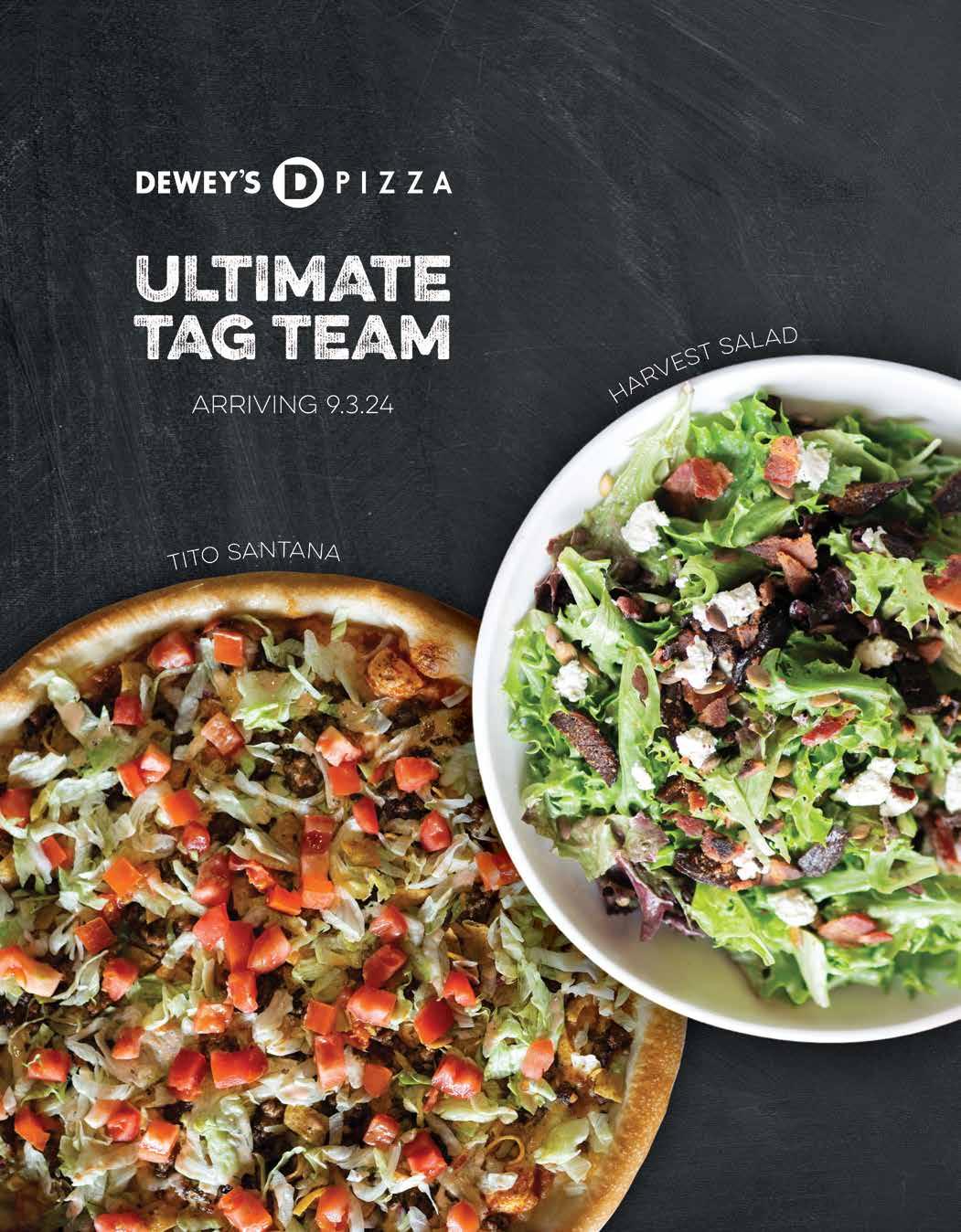
BY LAUREN SERGE
arly Sioux is returning to her roots here in Cincinnati. The interior designer, artist and businesswoman brings along her stylishly curated interiors business, called House of No Era, which is setting up shop in Camp Washington.
Sioux initially worked in freelance interior design in New Orleans, settling there from 2016 to 2023. During the pandemic, she decided to break away from freelance work and start her own company that fulfilled her creative vision.
House of No Era encompasses art, design, fashion and interiors. The business offers an array of design services, including interior styling and staging fine consignment. Sioux works to buy, sell and collect items and showcase them in a way that is appealing for customers and reflects her personal style.
“No Era implies a sort of timelessness,” Sioux said. “I think it’s a more clever way of saying eclectic because eclectic almost sounds like you don’t have a defined style, but with No Era, it’s about choosing some of the best pieces across the broad spectrum of time and having all of these pieces live together harmoniously.”
While Sioux’s pieces do not fall under one specific era or style, she does tend to gravitate towards certain periods that strike her.
“I would definitely say some standout periods for me would be 1970s Italian,” Sioux said. “I like to mix that a lot of times with European Art Deco pieces. I’m really into a lot of coastal postmodernism. And then I also really love a lot of the mid-century modern classics that got more interesting later into the midcentury period.”
Sioux’s interest and fascination for art, interiors and fashion have been ingrained in her throughout her life. She studied at the Fashion Institute of Technology in New York, majoring in visual art management. Her studies encompassed both the creative and business aspects of the design and art industries, something that Sioux has greatly utilized in the formation of her own business.
“I think a lot of people think that design is just making things look pretty, but design is problem-solving,” Sioux said. “Part of the parameters that you have to work around are client expectation, deadline, budget, quality. There’s a lot of things that you’re balancing and, so, there’s a lot more business that goes into it and then you just happen to be fortunate that you have good taste.”
While Sioux loved her time in New

Orleans during the early days of her business, after a while, the area was no longer realistic for her artistic endeavors. In late 2023, she found herself drawn back to her hometown of Cincinnati, believing the city would serve as an energetic landscape for herself and her clientele.
“Everything comes and goes through Cincinnati,” Sioux said. “You’re so close to so many great cities and Cincinnati has really beautiful architecture. It’s a place where people come to make things happen and work and get things done. It’s a very productive city and I was very drawn to that. It just felt like the right place for me to come and actually put roots down.”
Throughout the time she spent away from the city, Sioux recognized the developments that Cincinnati has undergone over the last 20 years, encouraging her to reconnect with the city — and the Midwest overall — to recapture the urban energy she wanted as the backdrop for her artwork.
“My slogan for No Era when I first came back to Cincinnati was ‘the dream of ‘90s Soho is still alive in Cincinnati,’ where you can still have these beautiful loft spaces and in places that feel cool and interesting,” Sioux said. “It’s not that interesting to live in New York anymore.
There’s no space for creativity because it’s just so expensive to be there. I think in the coming years, places like Cincinnati and Detroit and Chicago are going to see a lot of people migrating from some of these other cities that are just not as inhabitable.”
With her move to the Queen City, Sioux hopes other individuals will recognize these progressions too, and she aims to collaborate with other local artists who share similar sentiments.
“Sometimes Cincinnati gets a bad rap, but I think that comes from a lot of people that just quite frankly don’t know what they’re talking about and don’t have the ability to see the vision of what this place has to offer,” Sioux said. “Cincinnati still has that underground, urban raw environment that I think is really conducive for creativity and production.”
While Sioux has focused a lot of her time on collecting items to showcase, she has recently moved to developing her consignment business, called Chairish. Sioux has clients in New Orleans, Miami, New York and now Cincinnati, allowing folks to either shop locally inperson or purchase online.
“I started to notice that there was a huge gap in the market for people that have higher-end furniture and they often don’t have the outlets to be able to sell
them and get a good return on their investment,” Sioux said. “Creating this consignment business was a really great way for me to help people out while also cutting through the sourcing process and have it be less time-consuming and more valuable for customers.”
This consignment venture ultimately allows Sioux to conduct her business from anywhere, but she is excited for Cincinnati to be the sole location of her in-house studio.
“I’m trying to explore what it’s like to be local in a global world,” Sioux said. “E-commerce and social media allows us to be in several places at once. So, that’s kind of my goal — I want to be everywhere. But, I think Cincinnati is a really great base for me.”
While Sioux works to establish her business in the city and beyond, she is hopeful that her desire to curate, collaborate and create will be welcomed by Cincinnati residents and artists alike.
“I’m happy to be here,” Sioux said. “When you’re from the midwest, there’s a shared value — everyone has a similar work ethic. Cincinnati has the right energy and momentum. It feels really good to be back.”
To learn more about House of No Era, visit houseofnoera.com.


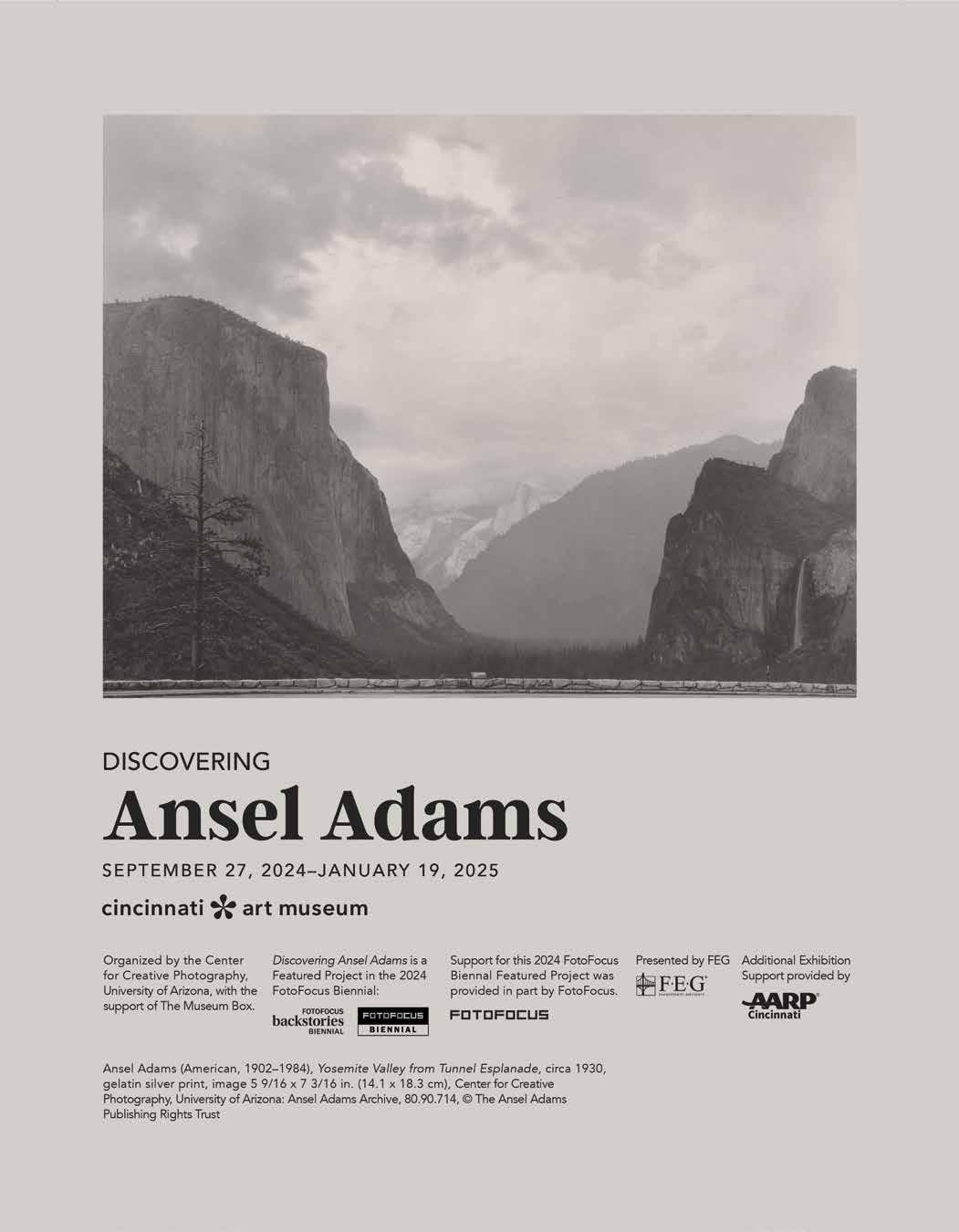

BY CAROLINE BECKMAN
International travel is a dream for many people, but for many reasons — ranging from time to money to finding kid-friendly destinations — it’s a lot easier said than done. If you want to experience different cultures and get out of your comfort zone without breaking the bank or making life more difficult, one way to do that is to eat at diverse restaurants serving up the cuisines of the world — and you don’t even have to leave the Greater Cincinnati area to do just that.
Certain restaurants, such as Jeff Ruby’s Steakhouse and Jose Salazar’s many restaurants, and foods like Cincinnati-style chili, put Cincinnati on the map, but Cincinnati’s food scene is much larger and more diverse. The extent of that diversity can surprise even native Cincinnatians. Sure, there are Chinese, Mexican, Italian and Indian restaurants, just like almost every large city in the United States, but you can expand your horizons even further while sticking close to home.
You don’t even have to leave Findlay Market. The oldest continuously operated public market in Ohio, Findlay Market is located in Over-the-Rhine, which has at various points been an enclave for German immigrants, Appalachian migrants and the Black community, among others. With that history in mind, it’s no surprise that the market is a hub for diverse businesses. In one trip through the market and down surrounding streets, you can eat food from Colombia and Venezuela (The Arepa Place), Eastern Europe (Babushka Pierogies), the Mediterranean (Dean’s Mediterranean Imports), Vietnam (Pho Lang Thang), Jamaica (Flavors of the Isle) and more. Chacabanas, which serves Dominican and Cuban food (and the best empanadas I have ever tasted), also operated at Findlay Market before closing that location and moving to a to-be-determined new permanent location and launched a pop-up at Somerset Bar. Findlay Market’s business incubator, Findlay Kitchen, helps burgeoning restaurants and foodcentered businesses get on their feet. Findlay Kitchen’s mission is to enable a
thriving, inclusive community of food entrepreneurs representative of the city’s diversity. Ninety percent of members and graduates are women-, BIPOC-, and immigrant-owned businesses.
One graduate of Findlay Kitchen is Ebony Williams, owner of Flavors of the Isle. Of African-American and Liberian descent and raised in Detroit, she grew up helping her Jamaican stepfather cook. After moving to Cincinnati, she noticed a lack of diverse eateries in Cincinnati and opened Flavors of the Isle, which offers Jamaican dishes, such as jerk chicken and rice and peas alongside soul food classics like collard greens, to help alleviate the shortage.
I stopped in recently to try Jamaican food for the first time. The space is small but gorgeous, with deep blue walls that evoke the ocean. The music of Bob Marley played over the speakers. The dishes I ordered, chickpea curry and rice and peas, were flavorful and delicious and at once new to me and reminiscent of old favorites such as red beans and rice. Flavors of the Isle provided not just good food but an experience, and I can’t imagine a better introduction to Jamaican food.
Beyond Babushka Pierogies, owner Sarah Dworak brings traditional dishes and twists on the flavors of her UkrainianAmerican upbringing in a variety of settings. Wódka Bar in OTR offers Eastern European light bites and cocktails based around vodka. Her newest restaurant, Sudova, serves classic Eastern European meals like rye pelmeni (meat dumplings) and green borscht (a Ukrainian sorrel soup) with modern twists. Dworak’s restaurants celebrate both history and the future, the homeland and the United States.
Neighborhoods such as Clifton and Corryville have so many diverse options that a person could get lost in the options. One such option is Baladi Restaurant & Bakery, owned by the Barazi family, who moved to Ohio in the ‘80s to escape turmoil in Syria. They brought their food traditions with them at Baladi, where they serve flavorful, fresh and delicious Syrian food alongside Syrian hospitality.

Situated in a small strip of businesses on Clifton Avenue with an unassuming façade, Baladi is decorated simply with beautiful accents, and the décor perfectly reflects the food.
Often, the simple act of eating at a restaurant can tell you about the history of the country the food hails from. Nowhere is that truer than at Bridges Nepali Cuisine, a chain of Nepali restaurants with locations in Northside, Elmwood, Covington and another scheduled to open in Walnut Hills. Nepal is located between China and India, so it’s no surprise that Nepali food has influences from both countries, while also retaining its own distinct identity. The highlight of the menu is the momo, a dumpling that looks like Chinese xiaolongbao with flavors akin to Indian food. Another noteworthy dish is chow mein, which is often associated with Chinese food but was brought to Nepal by Tibetan settlers. Chow mein is also a feature of IndianChinese cuisine, and the last time I went to the now-closed downtown location, I struck up a conversation with a man from India who fondly remembered the chow mein he ate in Delhi. The chow mein at Bridges, he told me, was the most similar he’d ever found in the United States.
Malaysian food also has influences from China and India, alongside the native ethnic groups and many others. In addition to many indigenous Malay ethnic groups, Malaysia is home to the descendants of the Peranakan Chinese (who migrated to Southeast Asia between the 14th and 17th centuries and intermingled over the centuries with local populations), more recent Chinese immigrants
and Indian immigrants. One Mt. Lookout restaurant, Sago, owned by Malaysian chef Paul Liew, showcases and celebrates this history. Dishes like samosas and vegan mapo tofu, typically associated with Indian and Chinese cuisines, respectively, sit alongside nasi lemak, a Malay meal considered the national dish of Malaysia.
If you don’t live within the city limits of Cincinnati, worry not. There are plenty of diverse food offerings in the surrounding area, from Afghan Grill (Afghan) in Liberty Township to Chaykhana N1 (Uzbek) in West Chester to Restaurant y Pupuseria Mari (Salvadorean) in Hamilton to East African Restaurant (Somali) in Florence and many more. The proximity between these places of interest makes it easy to stop by during other trips, but a taste of a new land is worth a trip of its own.
In addition to brick-and-mortar restaurants, many food trucks offer diverse, unique offerings. These offerings range from Mama Afrique, which serves Nigerian classics such as jollof rice and the best plantains I have ever tasted, to Twisted Greek, which pairs traditional Greek flavors and ingredients with modern presentations and beyond. These food trucks can be found at events like Taste of Cincinnati and West Chester’s Union Centre Food Truck Rally.
Food festivals are another wonderful way to taste the world. From the Asian Food Festival in April to Cincy-Cinco in May to AfriFest Cincy in July, one can travel around the world in just a few festivals in one summer.
The cuisines of the world are just a few miles away from your doorstep.




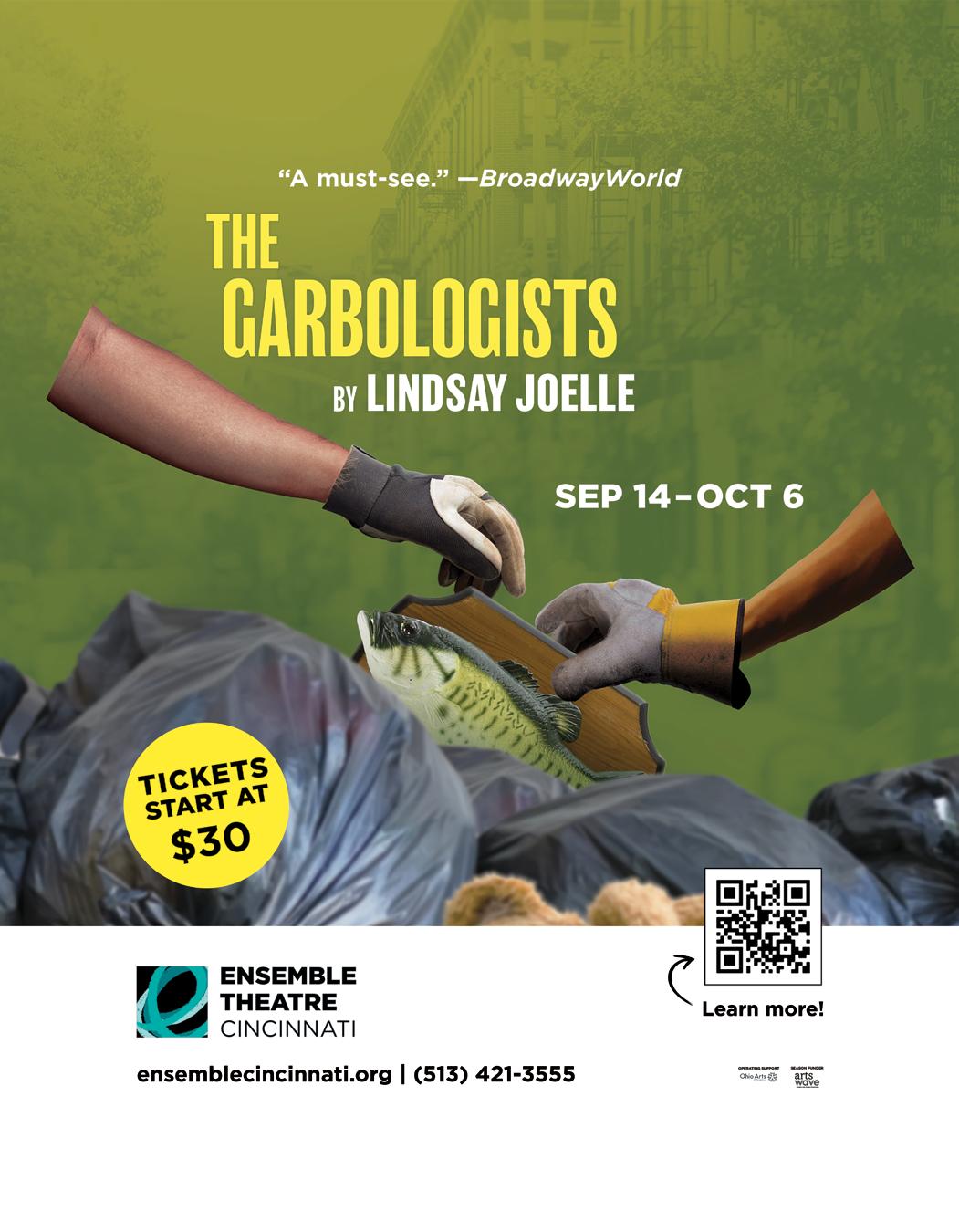

Esperanza Spalding discusses collaborations, finding joy in her music and more ahead of her Cincinnati show.
or sometimes we are creating art that’s an aspirational representation of who we want to be. I think that in all the things that I’ve done, even if I’m trying to present a persona or polish out aspects that I don’t want the public to know about, I think ultimately who I am is legible in everything. This project is a portrait of two people’s relationship — our relationship to the music, primarily, and also our relationship to each other.
or sometimes we are creating art that’s an aspirational representation of who we want to be. I think that in all the things that I’ve done, even if I’m trying to present a persona or polish out aspects that I don’t want the public to know about, I think ultimately who I am is legible in everything. This project is a portrait of two people’s relationship — our relationship to the music, primarily, and also our relationship to each other.
CB: How did you come to your take on Wayne Shorter’s “When You Dream?” Did you find it daunting to conjure a version of your own?
CB: How did you come to your take on Wayne Shorter’s “When You Dream?” Did you find it daunting to conjure a version of your own?
Esperanza Spalding discusses collaborations, finding joy in her music and more ahead of her Cincinnati show.
BY JASON GARGANO
BY JASON GARGANO
EEsperanza Spalding is a musical lifer. The Portland, Oreg. native has already packed more into her 39 years on planet Earth than some twice her age, releasing a series of crafty, jazz-informed albums that ride high on her expressive bass playing, versatile voice and contagious enthusiasm. Then there are her collaborations with a bevy of artists from across the creative spectrum, including two of her biggest influences — the late legendary saxophonist and arranger Wayne Shorter and, most recently, iconic Brazilian singer and songwriter Milton Nascimento.
speranza Spalding is a musical lifer. The Portland, Oreg. native has already packed more into her 39 years on planet Earth than some twice her age, releasing a series of crafty, jazz-informed albums that ride high on her expressive bass playing, versatile voice and contagious enthusiasm. Then there are her collaborations with a bevy of artists from across the creative spectrum, including two of her biggest influences — the late legendary saxophonist and arranger Wayne Shorter and, most recently, iconic Brazilian singer and songwriter Milton Nascimento.
Spalding’s latest full-length album, the recently released Milton + esperanza, features 16 tracks that range from the brief, ambient opener “the music was there” to an inspired reworking of Nascimento’s “Outubro,” which soars by way of the pair’s interweaving vocals and an arrangement peppered with flute, piano and synths, all anchored by a dexterous rhythm section. The album closes with a nine-minute cover of Shorter’s “When You Dream,” an adventurous reimagining that leaps into its own realm via the duo’s nuanced vocal emissions and a searching arrangement that ebbs and flows in unexpected, often affecting ways.
Spalding’s latest full-length album, the recently released Milton + esperanza, features 16 tracks that range from the brief, ambient opener “the music was there” to an inspired reworking of Nascimento’s “Outubro,” which soars by way of the pair’s interweaving vocals and an arrangement peppered with flute, piano and synths, all anchored by a dexterous rhythm section. The album closes with a nine-minute cover of Shorter’s “When You Dream,” an adventurous reimagining that leaps into its own realm via the duo’s nuanced vocal emissions and a searching arrangement that ebbs and flows in unexpected, often affecting ways.
CityBeat recently touched base with Spalding via phone to discuss her
CityBeat recently touched base with Spalding via phone to discuss her
collaboration with Nascimento and her yearning to connect with both her fellow musicians and those listening to her creations.
collaboration with Nascimento and her yearning to connect with both her fellow musicians and those listening to her creations.
CityBeat: Given your extensive catalog and various collaborations, what kind of set list can we expect for this tour? Will you be playing any of the new songs you recorded with Milton?
CityBeat: Given your extensive catalog and various collaborations, what kind of set list can we expect for this tour? Will you be playing any of the new songs you recorded with Milton?
Esperanza Spalding: For these gigs I do pull one Milton Nascimento song that I recorded for an earlier record but other than that it’s really music from my catalog. The reason I wanted to do this tour, which we started earlier this year, was because it had been a long time since I really focused just on my bass and my voice, like the core things that I do. I wanted to have a really stripped-down offering that was about the songs and the connection with the audience. I love all the projects I’ve been doing the last 10 years. They’ve all been very large concepts, a lot of ensembles, a lot of staging, and it wasn’t so much about engaging with the listeners, the people who are assembled in the room, in an intimate way.
Esperanza Spalding: For these gigs I do pull one Milton Nascimento song that I recorded for an earlier record but other than that it’s really music from my catalog. The reason I wanted to do this tour, which we started earlier this year, was because it had been a long time since I really focused just on my bass and my voice, like the core things that I do. I wanted to have a really stripped-down offering that was about the songs and the connection with the audience. I love all the projects I’ve been doing the last 10 years. They’ve all been very large concepts, a lot of ensembles, a lot of staging, and it wasn’t so much about engaging with the listeners, the people who are assembled in the room, in an intimate way.
CB: You mentioned the various projects you’ve juggled over the last several years. Were you hesitant to add another one
CB: You mentioned the various projects you’ve juggled over the last several years. Were you hesitant to add another one
when the chance to collaborate with Milton came up or was it an obvious “yes”? ES: Well, this is what I want to do. He’s my hero, and I love him as a human, as a person. Whenever life affords you these windows, you got to move with them. That’s how I want to spend my time. I am a writer and an arranger and a producer, and I love that, so it’s not like, “Oh no, I have to find time away from my life.” That is my life. That’s what I do, and I got to do it with the greatest, so it was very unexpected. It’s not something I was planning for on my calendar, but you just make it work. One of the people on the project posted some photos from last year, from different points along the year, and I was remembering just the sheer joy it was (making the record). When you’re in the middle of it, that’s all you’re thinking about. I wasn’t thinking about the other three things I had going on. It was a total, hilarious, beautiful, immersive joy to do.
when the chance to collaborate with Milton came up or was it an obvious “yes”? ES: Well, this is what I want to do. He’s my hero, and I love him as a human, as a person. Whenever life affords you these windows, you got to move with them. That’s how I want to spend my time. I am a writer and an arranger and a producer, and I love that, so it’s not like, “Oh no, I have to find time away from my life.” That is my life. That’s what I do, and I got to do it with the greatest, so it was very unexpected. It’s not something I was planning for on my calendar, but you just make it work. One of the people on the project posted some photos from last year, from different points along the year, and I was remembering just the sheer joy it was (making the record). When you’re in the middle of it, that’s all you’re thinking about. I wasn’t thinking about the other three things I had going on. It was a total, hilarious, beautiful, immersive joy to do.
CB: You can definitely hear and feel that joy coming through in the music. There are even various moments where you guys are laughing. And, of course, you’re both smiling on the album cover. Where does that joy come from?
CB: You can definitely hear and feel that joy coming through in the music. There are even various moments where you guys are laughing. And, of course, you’re both smiling on the album cover. Where does that joy come from?
ES: That’s who we are. It takes a lot of work to hide who you are when you’re making art. Some people succeed at it,
ES: That’s who we are. It takes a lot of work to hide who you are when you’re making art. Some people succeed at it,
ES: We weren’t going to put it on the record if it wasn’t stunning, if we don’t love it, but it wasn’t quite working (at first). I remember we were talking about it and trying different ideas and then I just remembered something Wayne would say, and it kind of shook out everything we had planned and we just hit an inspiration — we have to do it “untethered,” like the way the Ornette Coleman Quartet would play a melody. So, we went back into our booth, and I remembered it had to be fun for us. It couldn’t be just us paying homage to Wayne. If we’re getting so caught up in the prestige and seriousness of honoring him, we’re not going to be honoring him. So, personally I wasn’t going to be worried about playing well. I’m literally just going to play what is fun, what is a blast to play. And then it just happened. We did it. We recorded it in two halves. We did it from the beginning to the middle. And then we played it from the middle to the end. And afterward we were like, “Yeah, that’s it. Let’s not touch that.”
ES: We weren’t going to put it on the record if it wasn’t stunning, if we don’t love it, but it wasn’t quite working (at first). I remember we were talking about it and trying different ideas and then I just remembered something Wayne would say, and it kind of shook out everything we had planned and we just hit an inspiration — we have to do it “untethered,” like the way the Ornette Coleman Quartet would play a melody. So, we went back into our booth, and I remembered it had to be fun for us. It couldn’t be just us paying homage to Wayne. If we’re getting so caught up in the prestige and seriousness of honoring him, we’re not going to be honoring him. So, personally I wasn’t going to be worried about playing well. I’m literally just going to play what is fun, what is a blast to play. And then it just happened. We did it. We recorded it in two halves. We did it from the beginning to the middle. And then we played it from the middle to the end. And afterward we were like, “Yeah, that’s it. Let’s not touch that.”
CB: How do you go about creating the aesthetics for the related stuff beyond the music: the videos, the album art, the stage presentation. It all seems to flow together well.
CB: How do you go about creating the aesthetics for the related stuff beyond the music: the videos, the album art, the stage presentation. It all seems to flow together well.
ES: Yeah, I work with really brilliant, smart people. All of our brief, for anything we’re doing, is that it’s got to feel like the music. The music is the guide. You can’t actually translate music into visuals. You can do it like beta or visual sonification, but it’s still abstracted, it’s still representative. But the feelings and the sensorial textures, the states, the emotional registers of music, you can kind of store those in your body and use that for the energies you’re going to convey down through your wardrobe choices to the texture of the photos to the color schemes of the set. The record was the brief. I’m always advocating for the visuals to be in resonance with the state of the music, what the music is transmitting. The aesthetic is very intentional and guided by the spirit of the music.
ES: Yeah, I work with really brilliant, smart people. All of our brief, for anything we’re doing, is that it’s got to feel like the music. The music is the guide. You can’t actually translate music into visuals. You can do it like beta or visual sonification, but it’s still abstracted, it’s still representative. But the feelings and the sensorial textures, the states, the emotional registers of music, you can kind of store those in your body and use that for the energies you’re going to convey down through your wardrobe choices to the texture of the photos to the color schemes of the set. The record was the brief. I’m always advocating for the visuals to be in resonance with the state of the music, what the music is transmitting. The aesthetic is very intentional and guided by the spirit of the music.
Esperanza Spalding plays Taft Theatre on Sept. 13 at 8 p.m. More info: tafttheatre.org.
Esperanza Spalding plays Taft Theatre on Sept. 13 at 8 p.m. More info: tafttheatre.org.
BY BRENT STROUD

Beatle Ringo Starr will be making a local appearance at Fraze Pavilion on Sept. 15 with a handful of famous friends for the latest version of his hit-heavy supergroup, Ringo Starr & His All-Starr Band. Starr is more famous than famous. The Beatles are a cultural landmark and reference point for a seemingly endless list of musicians. The group is as synonymous with pop culture and music history as the air we breathe. From the band’s early rock and roll blast to the pop superstardom of Beatlemania and on through their experimentation and maturity as songwriters later in the decade, any person who sits down to write a song since is likely pulling from the various innovations and strokes of genius that they delivered to the world.
The All-Starr Band first formed in 1989, and has featured some of Starr’s most famous friends and peers over the years in its different lineups.
“I am the drummer, so I need a band in front of me. In ‘88 I had this thought, in ‘89, I started making it come true,” Starr tells a group of journalists from around the world, that includes CityBeat, in a live feed press conference over Zoom. “I do it so I get to play and I get to play with a lot of good players and I play all their songs and they play mine, but I also then get a spot in the front, which is great too. I still do it because I love it and I still do
because I can.”
In addition to Beatles hits like “Yellow Submarine” and “With A Little Help from My Friends,” fans can expect songs like “Boys” by The Shirelles that Starr has done since he was high up on a drum riser, his famous mop top bouncing around while he sang in concert halls at the height of Beatlemania. Additionally, the All-Starr Band members bring their individual hits to the show to create a soundtrack that spans across decades of the FM dial.
The latest version of the group features Steve Lukather, singer and guitarist of Toto, Colin Hay of Men at Work and songwriter Hamish Stuart of ‘70s funk powerhouse group the Average White Band.
All-Starr veteran, Edgar Winter, creator of the otherworldly 1973 instrumental hit “Frankenstein” and good-time ‘70s classic “Free Ride,” returns along with saxophonist and multi-instrumentalist Warren Ham. Longtime All-Starr Band drummer, Gregg Bissonette, who has played with Starr since 2008, also returns. Of Bissonette, “I have him because I heard he does seminars on the way I play,” Starr says of Bissonette before mimicking picking up a phone, “‘Hey, Gregg, come on over.’ Musically it just falls into its right space, you know, that’s what’s great.”
Starr, now 84, continues to be a
showman, seemingly full of energy on and off stage, as well as in our nearly hour-long meeting. He talks a little about how he keeps in shape. “I put some time in, you know, I work out, I watch what I eat. I’m on the road, I’m making a record, I keep busy.”
“Crooked Boy,” his latest in a string of recent EPs, came out in the spring and Starr has announced that he will be releasing a country record produced by revered roots music producer/musician T Bone Burnett sometime this fall, his first in the genre since the 1970 solo release, Beaucoups of Blues.
Starr says the new record came to be when he ran into Burnett at a poetry reading held by George Harrison’s wife, Olivia Trinidad Harrison, and that the idea was born as a result of the chance meeting.
When asked by CityBeat if the new record felt like a return of sorts to his first country album Beacoups of Blues, the ever-playful Starr replied with a deadpan, “Yeah,” followed by a pause and a laugh before saying, “That was another accidental situation. George (Harrison) had called Pete Drake in Nashville to come play on his record (All Things Must Pass), and I played on it, Peter Frampton’s on it, a lot of us are on it, but anyway, it just happened that I sent my car to Heathrow Airport to pick Pete up and he comes and gets into the studio and says, ‘Hey Hoss,
I see you like country music because there’s a lot of cassettes in the car.’ In those days, it was cassettes, children. And he said, ‘Oh, you’ve got to come to Nashville.’ I said, ‘Oh, I don’t know about that, you know, a month in Nashville,’ because that’s roughly how long it used to take us to make a record, and he said, ‘What? Nashville Skyline (a Bob Dylan album produced by Drake) was done in two days, and we can do one on you in two days.’ So, I flew to Nashville and he was there and we picked five songs in the morning and we’d record them and finish them at night. And the next day we did five songs; we’d pick five songs out of like 20 that writers … and it was done in two days. It was far out.”
He continues with a memory of the sessions, “I was singing one of the tracks and he said, ‘Hoss, put some emotion in it or I’ll come out there and step on your toes,’” Starr recalls with a laugh. “It was like, ’Ok,’ but I had a great time doing it.
The current tour will be leading up to the release of the new record.
Ringo Starr & His All-Starr Band will make a local stop at the Fraze Pavilion mid-way through a limited 12-date run that ends at New York City’s Radio City Music Hall this September.
Ringo Starr and His All-Starr Band play the Fraze Pavilion on Sept. 15 at 8 p.m. More info: fraze.com.


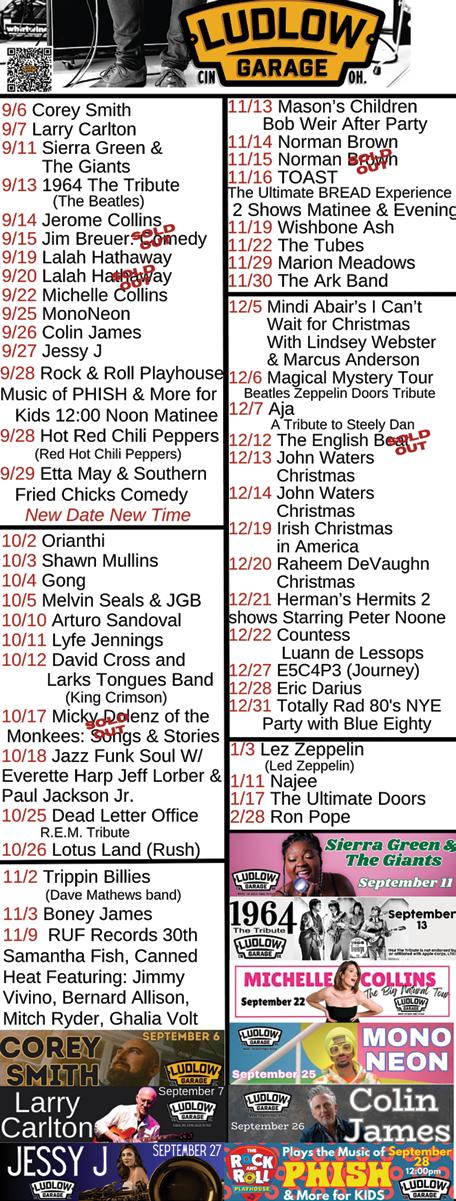




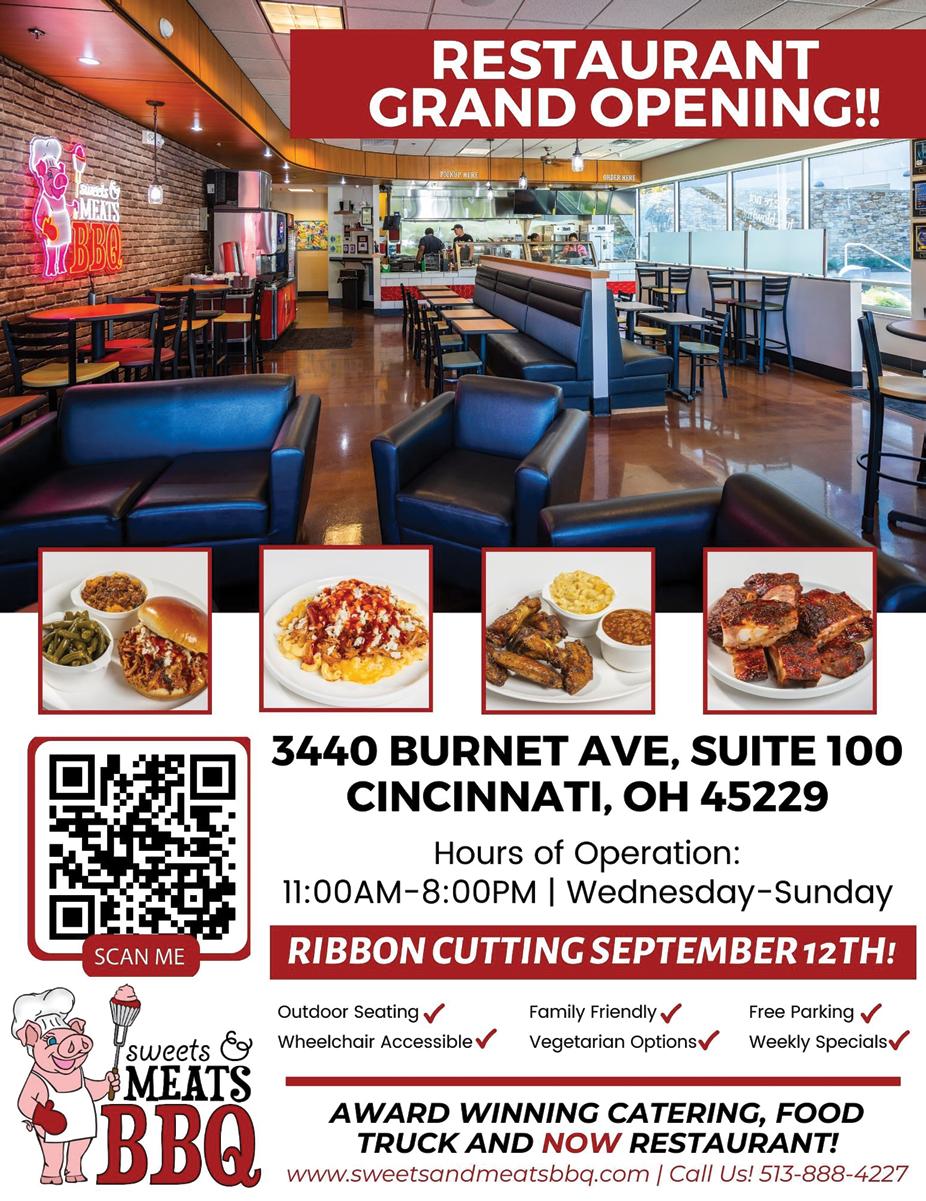
BY CHANELL KARR
entucky roots run deep for Tobias Grave, frontman of post-punk band Soft Kill. His father, Toby Francis, and uncle, Elwood Francis, were the first of the family to escape Hazard, Kentucky, and hit the road to work with some of the most iconic bands of the ‘80s. This would inevitably introduce Grave to the punk rock world.
Grave’s journey hasn’t been without adversity. He is very open about overcoming his own battles with abuse, addiction and the deaths of loved ones — which are all themes that can be heard in his lyrics throughout each Soft Kill record.
CityBeat recently connected with Tobias Grave over the phone while he was grocery shopping before getting a new tattoo — the definition of punk rock.
CityBeat: We’re just really stoked about you guys coming to Covington/the Cincinnati area to play the show.
Tobias Grave: A big chunk of my family is from Kentucky, so I grew up spending summers and holidays mostly outside of the Lexington area. They’re originally from Hazard, but they escaped the conditions of coal mining. I think my dad and his brother — my uncle — are one of the first generations to get out of Hazard. My dad has this really great story about it. If it’s not true, I want it to be true. His grandfather took him all the way to the bottom of a coal mine, and turned the lights off, and said, “Do you feel that? That’s all that’s here for you if you stay.”
CB: That’s heavy. I love it when people have some Kentucky ties. Did you grow up in Kentucky?
TG: No, my dad and my mom split when I was 7, but my dad and my uncle are both roadies by trade. They essentially just followed the road, which was definitely not conducive to maintaining relationships with family and things of that nature, but it did well for them. My dad nowadays does sound for really big bands, and his brother plays bass in ZZ Top. My uncle — he’s the one who set me on the course of making music to begin with — he got me into all of my baseline punk bands that I still love. When I was a kid, when my dad was still with my mom, they both worked for Aerosmith, and we lived only 45 minutes north of Boston. My uncle got the ZZ gig in the mid ‘90s, and when Dusty (Hill) was sick, my uncle stepped up just to fill in for the shows. Unfortunately, Dusty passed away, and he’s kept playing bass. So my dad and him both have, like, a storied list of people that they’ve worked for. While I didn’t grow up with my dad, I definitely grew up with the influence of both of them.
CB: You’re in the Chicago area now, right? I’ve seen that Soft Kill is considered a
Portland band.
TG: Yeah, I chose Chicago as my second home. The band has always associated as a Portland band. It’s mainly that the initial record label that put out the first album was Portland-based. That was where the band got assembled for the first lineup of shows.
CB: Before the band was Soft Kill, was it a different band altogether or just went by a different name?
TG: The band prior to this was called, the technical pronunciation was (speaks with a French accent) Blessure Grave, but being like a trash American idiot, I read it on the inside of a car visor, and I was like, “oh, that’s a great punk band name.” And that was a really raw, strictly home-recorded version of similar ideas that became Soft Kill. But Soft Kill initially was really rooted in guitar-driven ‘80s new wave, post-punk stuff like Magazine, and The Chameleons and Sad Lovers & Giants. It was really trying to be something in particular, matched with a fidelity from recording in a studio, that kind of just took it to another level. It definitely did feel enough of a progression to be something that was its own, but it is legitimately the same path, and band, in a lot of weird ways.
CB: I had read that you were influenced by the music of John Hughes films. Do you have a connection with those films?
TG: With John Hughes, those movies were, in a weird way, kind of subculture films. We didn’t have a lot of movies where people worked in record stores and listened to new wave and punk. I would say that my favorite — I personally adore and love all of them quite a bit — but Pretty In Pink is like my fantasy of life. As a child, at least. I mean, she is off-kilter in a way that is so realized and mature for the age. And I think that’s what being a young punk rocker was like in Seacoast, New Hampshire. I kind of just had to act like even though I had put a big old target on my head, that that was absolutely who the fuck I was, and you couldn’t tell me differently.
That’s what the world looked like when I was growing up. And it doesn’t really look like that anymore, and, again, it’s very nostalgically blissful and sad at the same time to visit those movies.
CB: Speaking of nostalgia, who are some of the influences that have inspired you to want to get into music? I’d imagine your father and uncle would have a lot to do with it.
TG: I saw …And Justice For All (album by Metallica) twice as a kid. I saw The Black Album (album by Metallica), and I was in the snake pit, and that was really pivotal for me. It was my gateway into punk rock, 100%. I visited my uncle who
was in Lexington at the time, and I went to a record store, I was like 13 or 14, and I bought Garage Days, and they cover The Misfits. Hearing their cover of “Last Caress,” which those lyrics haven’t aged well, I went to school in seventh grade and I had no friends, and I had green hair and I knew the words to that song and I didn’t really know anything about The Misfits. But me singing that song to myself at the table is what got — what became my core friend circle, to walk up to me and say, “Who the fuck are you?” Misfits are another heavy standard, trope-ish answer, but they are absolutely the core of my understanding of music. And it’s really bleeding through in the more recent shit too, just vocally.
Blitz, they were combining punk with more melodic, new wave, post-punk influences, which really became a blueprint for me, and how I heard even softer stuff being kind of presented aggressively. That shined through more and more as the years have gone on.
I could go on about a billion bands that don’t matter that were really influential to me, but the bands that really shaped me for Soft Kill — the main one is always going to be Mark Burgess of The Chameleons. The two-guitar interplay, the way that one person is playing really lush, pretty, atmospheric, and the other has a more aggressive approach. Those two layered together — there’s something about layering stuff like that and then putting simple bass right down the middle. It’s still doing it for me fucking 14 years later.
Definitely Magazine and Siouxsie and the Banshees. John McGeoch — he’s a guitar player — had this approach that was really game-changing for me. I finally sat down and spent time with it, and when I picked the guitar up, I just played it differently. So that was kind of the main reason that the first Soft Kill record sounds the way that it does, is his approach.
CB: I think you can definitely hear a lot of those influences within the different albums. Tell me a little bit more about the newest album, Escape Forever.
TG: Escape Forever was the most honest and enjoyable time. It was what I wanted my band at 15 to sound like. I was at home and finally had the skillset to make that come to life in whatever crude way possible. It’s a really big departure in terms of the comfort zone of most Soft Kill listeners. It didn’t come out as polarizing as I expected it to. There’s a lot of lows on the album, and there’s a lot of distorted guitar. Younger kids are coming to shows and connecting to it in a different way, which is pretty exciting. The second you start blasting bigger songs a little faster, a younger audience is going to walk into it, and the energy that they bring is just
priceless. It makes it so fun to play shows.
CB: I know that you’re very open and transparent about overcoming addiction. For those who might not know, are you willing to share your story?
TG: So, I come from a family of addicts, and they didn’t talk a lot about that stuff, and I had traumas and abuse and things like that growing up, which created a drive to be accepted into circles and groups that I never personally utilized alcohol or drugs to interact with. At 20 years old, I tried cocaine and then tried heroin within the same couple months, and heroin connected with me in a way that took over a decade and a half from my life.
I lost my cousin to an overdose. His death was the big catalyst for my dad and I to ever have our first honest conversations about my disease of addiction. Prior to that, I think a lot of my actions were definitely directly aimed at victimizing him for my own ability to stay using. We were able to talk and be like, “Hey, there’s something deeper going on here; maybe it’s relatable to you, maybe it’s not.”
I’ve got family members that are doing life in prison for sales of fentanyl in Kentucky, and I have family members who are dead and their kids are essentially orphaned by this stuff. It is a huge underlining part of the Soft Kill story, in that most of what inspires me to write music, in terms of the lyric half of things, is loss, and most of the loss that I have experienced has been at the hands of two very American things, which are drug addiction and gun violence.
We carry a bunch of Narcan and have it on the table. I talk on stage, especially before this one song, “Pretty Face,” about my story, and try to make it relatable. I’m six years clean. There needs to be people saying the dreaded disease word out loud. A lot of people think that the human choice of picking up is the end-all, be-all culprit, and there’s just so much more to it than that. I would love to have more resources related to treatment and recovery for the disease, and until we have that, I’m going to have to get on stage and whine about it.
CB: Incredible. Have you guys played in the Cincinnati area before?
TG: I played in Cincinnati a long time ago. I love Cincinnati. For me, it’s where my uncle grew up going to shows. The coolest part about making music and touring is going to new environments and towns and cities. I’m really excited to play Kentucky again. Kentucky and Cincinnati are special places in my heart. So I’m really honored and stoked that we’re going to get to go play songs there.
Soft Kill plays Madison Theater on Sept. 19 at 8 p.m. More info: madisontheater.com.
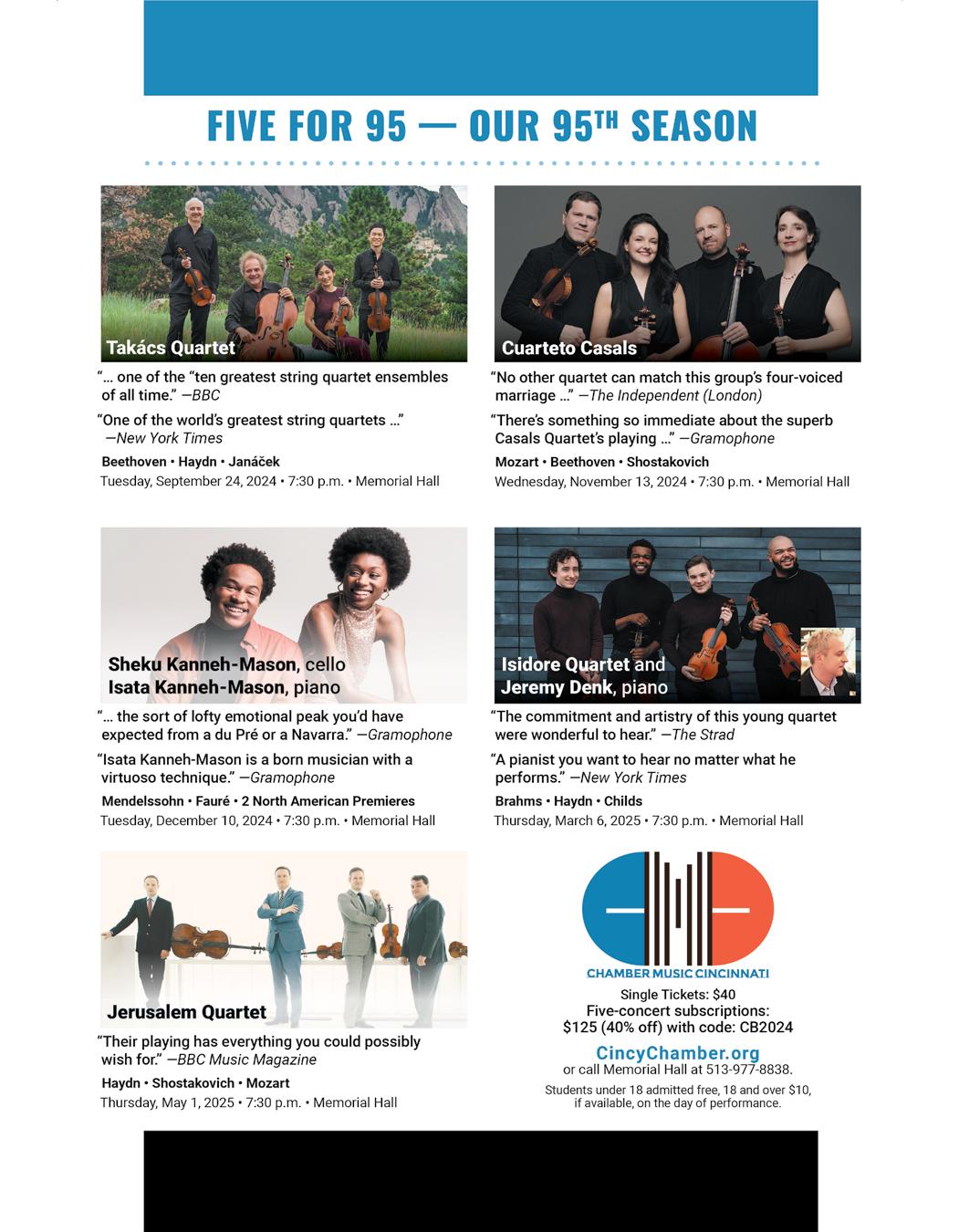

Sept. 10 • Andrew J Brady Music Center
Omar Apollo is stopping in Cincinnati on his “God Said No” world tour, following the release of his second studio album. After gaining a Grammy Award nomination for Best New Artist in 2023 for his first album, Ivory, Apollo followed this explosive debut with God Said No. At 14 tracks and 45 minutes long, the album delves into the inevitability of what life has to throw at you and the unpredictability of what comes in the aftermath of heartbreak.
The album’s title was a product of advice that Apollo’s friend gave him while reflecting on his relationship. “I gave it my everything,” he says, “And God said ‘no.’” More than that, it is also Apollo’s interpretation of the phrase, “lo que será, será,” or “whatever will be, will be.” Throughout the album, this phrase is brought to mind as fans join Apollo in his journey through both the denial and acceptance that undoubtedly accompanies heartbreak. There is even a feature of The Last of Us star, Pedro Pascal, on the album’s second-to-last track titled “Pedro.” Pascal speaks through what seems to be a voice note to Apollo, delving into his own experiences with the impracticality of dealing with heartbreak.
Born and raised in Hobart, Indiana,
Apollo is an openly gay MexicanAmerican singer/songwriter who advocates for LGBTQ+ rights and is unafraid to open up about his own experiences through his music. Apollo’s discography touches several genres, including R&B, alternative, pop, latin music and even soul. Opening for SZA’s “SOS” tour and Billie Eilish’s Latin America stadium tour in 2023, he is anything but restrictive when it comes to both the genres he explores as well as the artists he collaborates with. Supporting acts for the “God Said No” tour include Kevin Abstract, Malcolm Todd and Ravyn Lenae.
Omar Apollo plays the Andrew J Brady Music Center at 7:30 p.m. on Sept. 10. More info: bradymusiccenter.com. (Alanna Marshall)
Sept. 11 • Riverbend Music Center Who knew being an outlaw could extend one’s lifespan? Everyone mentions Willie Nelson’s longevity and the fact that he is still making music and touring at the age of 91. That fact is certainly remarkable but not surprising for a guy who continues to do what he loves no matter what outside
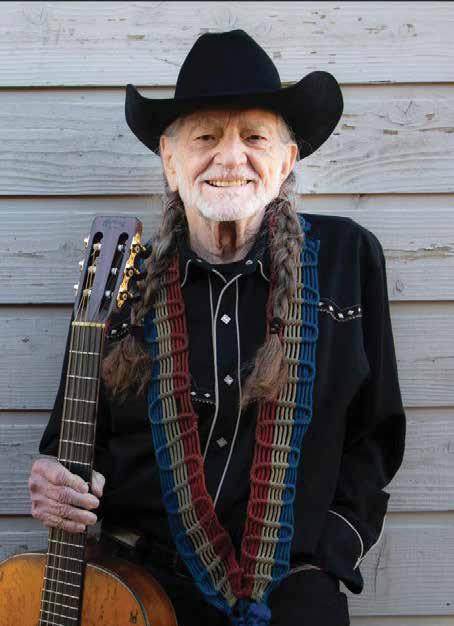
expectations or the laws of physics might suggest. All of which makes it no surprise that Willie is back on the road for another Outlaw Music Festival, a touring entity he founded back in 2016 that celebrates the rabblerousing nature of the country music scene he helped shape in the 1970s and beyond. None other than Bob Dylan, who at 83 also shows no signs of slowing down, John Mellencamp, who at 72 is nearly two decades younger than Willie, and Southern Avenue, a Memphis-based blues band featuring a sextet of thirtysomethings, join Willie and Family this time.
Expect Nelson to draw from his vast discography, including from his most recent album, this year’s The Border, his 75th studio effort, a surreal number that will grow even larger now that he has announced the release of yet another album in November, the aptly titled Last Leaf on the Tree. Studio stuff aside, Nelson’s dedication to delivering his music in a live setting is unwavering despite missing a few shows earlier this year due to health issues. Each show is another opportunity to deliver the Southwest-flavored
country and western music he grew up on — an eclectic meld of folk, bluegrass, rock and ragtime.
As ever, this year’s studio releases feature a timeless mix of originals and a handful of cover tunes anchored by Nelson’s weathered, ever-expressive voice and elegiac guitar playing. Then there is his recent duet with country upstart Orville Peck on “Cowboys Are Frequently, Secretly Fond of Each Other,” a queer classic Nelson reminds is more important than ever. Long live Willie Nelson.
Outlaw Music Festival takes place at Riverbend Music Center on Sept. 11 at 5 p.m. More info: riverbend.org. (Jason Gargano)
Sept. 11 • Riverbend Music Center Living legend Bob Dylan continues his never-ending tour with a stop in Cincinnati on Sept. 11 to join fellow songwriters Willie Nelson and John Mellencamp at the Outlaw Music Festival. With the exception possibly of Ringo Starr and Paul McCartney, Dylan is one of the last greats from an incomparable era of music — an era he all but defined.
There are moments every Dylan
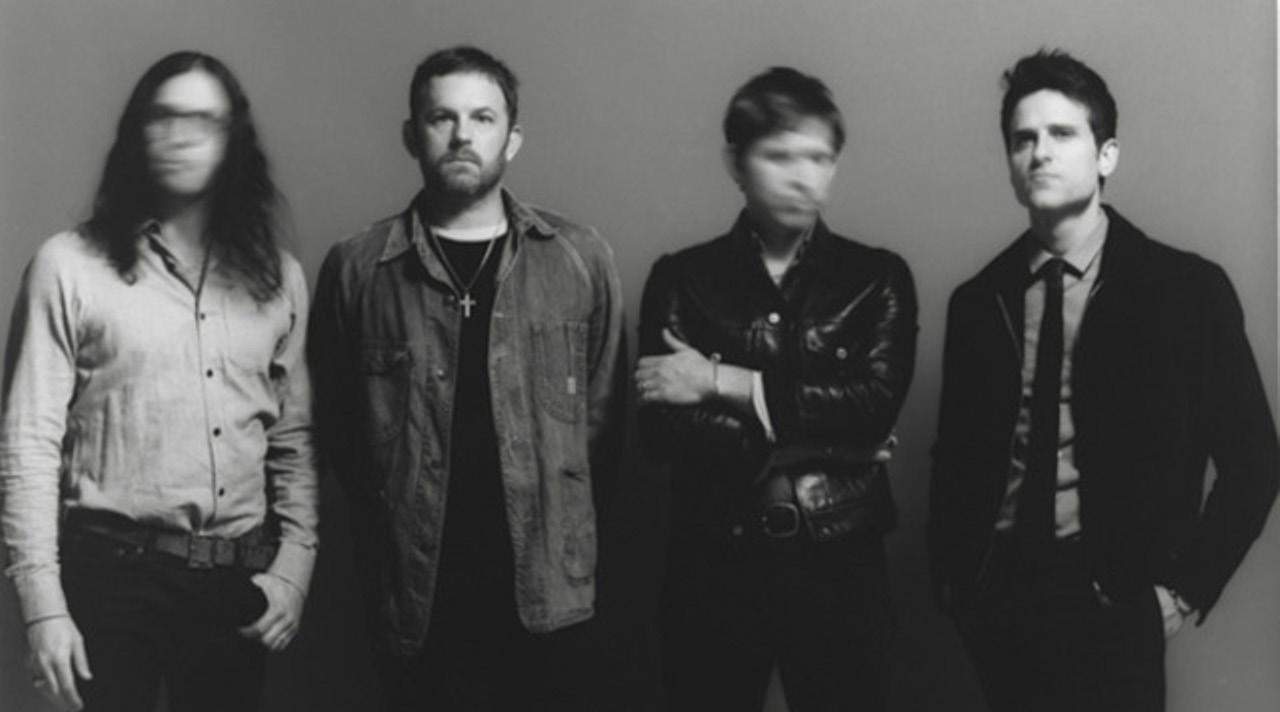

fan cherishes. Maybe it’s his backstage rendition of “It’s All Over Now, Baby Blue” in front of a visibly affected Donovan, captured in D.A. Pennebaker’s classic Don’t Look Back, or the chillinducing exchange between a disgruntled folk diehard at a Manchester concert in ‘66 and Dylan right before
he instructs The Band’s drummer, Levon Helm, to “play it fucking loud!”
And with that, he truly never looked back. Dylan has always been hard to pin down, and that’s what makes him so good. Like Picasso, he isn’t content staying in one place, often reinventing himself while everyone else is still
trying to catch up.
Hopefully, fans will get a chance to relive these storied scenes from Dylan’s uncompromising and eventful life on the big screen in the upcoming biopic A Complete Unknown, starring Timothée Chalamet as a young Dylan, directed by James Mangold. Whether touring, publishing books (like 2022’s The Philosophy of Modern Song), painting, sculpting or releasing new albums, at 82 Dylan shows no signs of stopping. The latest in his seemingly inexhaustible bootleg series will be The 1974 Live Recordings with The Band, set to be released on Sept. 20. A 27-disc set with 431 songs may sound like too much of a good thing, but with Dylan even his throwaways are gems. Better yet, witness the magic of Dylan firsthand — and then pick up that bootleg, say, thirty years down the line.
Bob Dylan performs as part of the Outlaw Music Festival on Sept. 11 at 5 p.m. at Riverbend Music Center. More info: riverbend.org. (Derek Kalback)
Sept. 14 • Andrew J Brady Music Center
Upon releasing their ninth studio album, Can We Please Have Fun, earlier this year, Kings of Leon embarked on a world tour that kicked off on Aug. 14 and will be stopping in Cincinnati mid-September. The band of brothers, including Caleb, Nathan and Jared Followill – along with their
cousin, Matthew Followill – have been together since the release of their debut album Youth & Young Manhood in 2003. Twenty years later, the band’s evolution continues in a fresh way with Can We Please Have Fun
While the Grammy Award-winning southern rock band is known for their hard-hitting hits including “Sex on Fire” and “Use Somebody,” the band took a different approach with this album. Opting for more of an indie rock energy and overall softer style throughout the 12 tracks on the album, this was the band’s first release with Capitol Records instead of their original label, RCA Records. The album was also produced by Kid Harpoon, known for his work with artists like Harry Styles and Florence & The Machine.
Having already been established as a band that easily produced radio hits and songs to sing along to throughout their career, Kings of Leon provides this same energy in an alternative way through singles like “Nowhere to Run” and “Mustang” shining through as some of the top tunes on their most recent album. Through the album’s enjoyable new influences combined with an homage to their roots as a rock band, Kings of Leon has made it abundantly clear that they always know how to have fun.
Kings of Leon play the Andrew J Brady Music Center at 8 p.m. on Sept. 14. More info: bradymusiccenter.com. (AM)

Across
1. Workforce
6. Broker’s advice
10. Way back in the past
13. Many a video game level, e.g.
14. Inter ___ (among others)
15. Clue weapon
16. Fold in a knight’s protection?
18. Shell product
19. Toy that you can “rock the cradle”
20. Charged particle
21. “You beat me”
23. Smuggling sausages?
26. Cut up a rug
29. Ilhan and Ayanna’s compatriot, for short
30. Now hear this
31. “___ Raids Fridge” (The Onion headline)
33. Spot on X where one might slide into
36. “Do you want to see some magic? This squirrel-like thing?”
40. When to leave, briefly
41. Words to live by
42. Actress Prepon
43. Frl : Germany :: ___ : France
45. Business news
46. Two things found on island-based reality dating shows?
51. “Sounds bad”
52. Wood problem
53. Native Americans of Northern Arizona
57. Fish for breakfast
58. Crazy cool, in dated hip-hop slang?
61. Barleywine, e.g.
62. Soup veggie
63. Stay the night
64. Some merch table offerings
65. “I’m all ___”
66. Extreme suffering
Down
1. Try and convince
2. Riding mower brand
3. Private group?
4. It picks up the acoustics at a basketball game
5. Pres. who implemented Social Security
6. Sitting room
7. Nicholas Gage’s book about his mother
8. Swimmer Thomas
9. Leather used in some saddles
10. Cow college student
11. Mexican tropical fruit
12. Beginning
17. Like some car freshener smells
22. Canyon creator
24. “Welp, if you say so”
25. Depilatory brand
26. Satisfy fully
27. Suffering
28. “That was me!”
31. Prefix with beat or futurism
32. “Before I forget,” initially
33. Pfizer product
34. Farm female
35. Name on the marquee
37. Breadmaker’s need
38. Zeno’s home
39. Aardvark, by another name
43. “Tell ___ story”
44. “The Murder at the Vicarage” detective
45. Cooks cook it
46. Purplish hue
47. Back in the day
48. Puts a spell on
49. Device with a lint trap
50. Pawns for cash
54. Really, really
55. Job for a physical therapist
56. Very small
59. Breakers break there
60. They may be frozen in a lab
LAST PUZZLE’S ANSWERS:

your
